Efficient simulations of dynamic wetting of flexible substrates - S. Aland
Efficient simulations of dynamic wetting of flexible substrates
Effiziente Simulationen der Benetzungsdynamik flexibler Substrate
PI: Prof. Dr. Sebastian Aland, Fakultät Mathematik und Informatik, TU Freiberg, 09599 Freiberg
PhD Student: Dominic Mokbel
Contact:
Mail: sebastian.aland@math.tu-freiberg.de
Tel.: +49 373139 2322
Die Benetzung elastischer Materialien (Soft Wetting) spielt eine bedeutende Rolle in der Natur und in technologischen Anwendungen. Um solche Prozesse zu simulieren, kombinieren wir den ALE Ansatz für Fluid-Struktur-Interaktion mit dem Phasenfeldansatz für Zweiphasen-Strömungen [3]. Im Rahmen des SPP konnten wir damit die erste numerische Methode entwickeln, um die Benetzung von viskoelastischen Substraten zu simulieren [1]. Die Methode konnte das Surfen der Kontaktlinie auf der Wetting Ridge reproduzieren und schließlich eins der herausragenden Soft-Wetting Phänomene enträtseln: die Stick-Slip Instabilität. In enger Zusammenarbeit mit dem Projekt von Stefan Karpitschka konnten wir die Dynamik und den Lebenszyklus der Stick-Slip-Bewegung aufzeigen und den Einfluss aller relevanten Parameter charakterisieren [2].
In der nächsten Förderperiode soll die Methodik in zwei Richtungen erweitert werden, die bisher numerisch völlig unzugänglich sind. Erstens werden wir eine numerische Methode entwickeln, die den Dissipationsmechanismus an der Kontaktlinie zutreffend beschreibt, indem sowohl Slip als auch dynamische Kontaktwinkel einbezogen werden. Zweitens werden wir die Methodik auf dünne elastische Strukturen erweitern, welche als niedriger-dimensionale Hyperflächen dargestellt werden, um die einhergehenden Auflösungsprobleme lösen. Das resultierende Mehrskalenmodell wird es zum ersten Mal erlauben die Benetzungsdynamik an Membranen, weichen mikrostrukturierten Oberflächen, Haaren, und anderen dünnen Objekten zu simulieren.
Mit den entstandenen numerischen Methoden untersuchen wir spannende Phänomene, welche bisher nicht verstanden sind: (i) das Zusammenspiel von Benetzung und Formdynamik von Biomembranen, (ii) die komplexe Benetzungsdynamik auf strukturierten, elastischen Oberflächen und (iii) der Einfluss eines adaptiven Lubrikationstropfens auf die Kontaktlinienbewegung öl-haltiger Substrate. All diese Punkte werden in Kooperation mit experimentellen und theoretischen Projekten des SPP durchgeführt, um schließlich ein tieferes Verständnis für die grundlegende Physik hinter der Benetzungsdynamik auf elastischen Materialien zu schaffen.
Wetting of elastic substrates (soft wetting) plays a major role in a broad variety of phenomena in nature and technology. To simulate such processes, we combine the ALE approach for fluid-structure interaction with the phase-field approach [3] for two-phase flow. Within this project we have developed the first numerical method for wetting on viscoelastic substrates [1]. The method enabled the first simulation of contact-line surfing and was then successfully applied to unravel one of the outstanding phenomena in soft wetting: the stick-slip instability. In a tight collaboration with the project of Stefan Karpitschka, we were able to reveal the onset dynamics and the life cycle of stick-slip motion and to characterize the influence of physical parameters [2].
For the upcoming funding period we aim to extend the methodology in two directions, which have remained completely unexplored so far. Firstly, we will develop a numerical method to account for an accurate dissipation mechanism at the contact line by including slip and dynamic contact angles. Secondly, we will extend the methodology to thin elastic structures, which are involved in the majority of soft wetting phenomena. Representing thin structures by dimensionally reduced hypersurfaces will solve the associated resolution problems. The resulting multiscale model will permit for the first time to simulate soft wetting phenomena at membranes, thin sheets, microstructured surfaces, hair and other thin objects.
The numerical models are applied to investigate three exciting phenomena that have been discovered in experiments: (i) the intense interplay of wetting and shape dynamics of biomembranes, (ii) the wetting dynamics at elastic structured surfaces, and (iii) the influence of an adaptive lubrication drop on the contact line motion on oil-absorbing substrates. All these points are addressed in collaboration with experimental and theoretical projects within the SPP to finally establish a deeper understanding of the fundamental physics behind the dynamic wetting of elastic materials.
References:
[1] S. Aland & D. Mokbel. (2021). A unified numerical model for wetting of soft substrates. International Journal for Numerical Methods in Engineering. 122: 903-918. https://doi.org/10.1002/nme.6567
[2] D. Mokbel, S. Aland, and S. Karpitschka. “Stick-Slip Contact Line Motion on Kelvin-Voigt Model Substrates”. (submitted to EPL), preprint at: http://arxiv.org/abs/2201.04189
[3] Aland, S., & Chen, F. (2015). An Efficient and Energy Stable Scheme for a Phase-field Model for the Moving Contact Line Problem. International Journal for Numerical Methods in Fluids, 81(11), 657–671. https://doi.org/10.1002/fld.4200
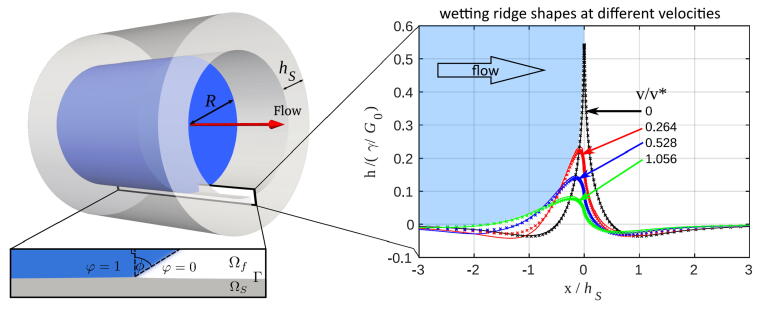
Impact of co-nonsolvency effects on dynamic wetting - G.K. Auernhammer, A. Fery, P. Uhlmann
PI1: Günter K. Auernhammer, Leibniz-Institut für Polymerforschung Dresden e.V., Institut Physikalische Chemie und Physik der Polymere, Hohe Straße 6, 01069 Dresden, Germany
PI2: Petra Uhlmann, Leibniz-Institut für Polymerforschung Dresden e.V. (IPF), Institut Physikalische Chemie und Physik der Polymere, Hohe Straße 6, 01069 Dresden, Germany
Das primäre Ziel dieses Projekts ist weiterhin die Untersuchung des dynamischen Benetzungsverhaltens der Polymerbürsten mit Cononsolvency-Effekten. Der vorliegende Antrag für die zweite Förderperiode (FP2) baut stark auf den Ergebnissen der ersten Förderperiode (FP1) auf. Zu diesem Zweck wird das gleiche Modellsystem verwendet: PNiPAAm-Bürsten, die durch eine Grafting-To-Methode hergestellt werden und mit Wasser und Ethanol als Lösungsmittel und Co-Lösungsmittel haben. In FP1 haben wir einige wichtige Merkmale identifiziert, die auf eine Kopplung des dynamischen Benetzungsverhaltens und der Cononsolvency von PNiPAAm-Bürsten hinweisen. (i) Intensive (nicht unbedingt lange) Vorbenetzung mit Wasser oder Ethanol verändert die Benetzungseigenschaften stark, aber reversibel und langzeitstabil. (ii) Wiederholte Benetzung und die Zusammensetzung der Gasphase können die Benetzungseigenschaften verändern. (iii) Die Veränderungen der Benetzungseigenschaften korrelieren mit den strukturellen Veränderungen in der PNiPAAm-Bürstenoberfläche, wie sie mit der Summenfrequenzgenerations-Spektroskopie beobachtet wurden.Diese Ergebnisse werfen mehrere wichtige Fragen auf, die wir in FP2 behandeln wollen. (a) Welches sind die Parameter des Vorbenetzungsverfahrens, die hauptsächlich die statischen und dynamischen Benetzungseigenschaften für eine sukzessive Benetzung steuern? (b) Welche Lagerungs- und (Vor-)Benetzungsbedingungen verstärken oder verringern die Langzeitstabilität des induzierten Benetzungszustandes? (c) Wie hängt die Cononsolvency mit der Thermosensitivität von PNiPAAm in Bezug auf ihren Einfluss auf die Benetzung zusammen? (d) Zeigen Polymerbürsten, die einen Cosolvency-Effekt aufweisen, ähnliche Merkmale in ihrem Benetzungsverhalten wie solche mit Cononsolvency-Effekten? Um diese Fragen zu beantworten, werden wir eine Reihe von komplementären experimentellen Techniken anwenden (teilweise in Zusammenarbeit mit anderen Gruppen innerhalb des SPP). (i) Dynamische Benetzungsexperimente in einem breiten Bereich gut definierter Kontaktliniengeschwindigkeiten (von μm/s bis zu einigen zehn cm/s). (ii) Analysemethoden wie spektroskopische VIS-Ellipsometrie (Bürstenschichtdicke), AFM-basierte Techniken für die mechanische Charakterisierung, SFG-Spektroskopie für Strukturinformationen. (iii) Systematische Variationen der experimentellen Parameter, wie die Eigenschaften der Polymerbürste (Molmasse, Bürstendicke, Cononsolvency vs. Cosolvency-Effekt), die Zeitskalen und Kontaktliniengeschwindigkeiten sowie die Zusammensetzung der benetzenden Flüssigkeits- und Gasphase Durch die Kombination dieser Methoden wollen wir ein grundlegendes Verständnis dafür erlangen, wie die Benetzung von Polymerbürsten mit der Cononsolvency der Bürste zusammenhängt.
The molecular scale of switchable wetting - E. Backus
The molecular scale of switchable wetting
Die molekulare Ebene schaltbarer Benetzung
PI1: Ellen H.G. Backus, Max Planck Institute for Polymer Research, Ackermannweg 10, 55128 Mainz, Germany
and Department of Physical Chemistry, University of Vienna, Waehringer Strasse 42, 1090 Vienna, Austria
PI2: Mischa Bonn, Max Planck Institute for Polymer Research, Ackermannweg 10, 55128 Mainz, Germany
PhD student: Mirela Encheva
http://www.mpip-mainz.mpg.de/water_interfaces
https://pchem.univie.ac.at/forschung-arbeitsgruppen/ultraschnelle-und-nichtlineare-spektroskopie/
Intermolecular interfacial interactions co-determine macroscopic wetting properties, yet insights into wetting at the molecular level have been lacking. In this project we use photoswitchable surfaces based on spiropyran/merocyanine isomerization to instantaneously switch the surface’s wetting properties, and follow the molecular response of water in real-time. In the closed spiropyran form, the molecule is nonpolar, while it is zwitterionic in the open merocyanine form. Under UV light irradiation the merocyanine form is obtained; visible light switches the molecule back to the closed form. It is well-known that surfaces functionalized with the spiropyran/merocyanine pair behave hydrophobic for the spiropyran case, but hydrophilic for the merocyanine form. The ability to switch the hydrophobicity of these surfaces using ultrashort laser pulses – shorter than the timescales on which molecules reorient –provides a unique way to follow the response of water to a step change in the hydrophobic surface properties. In this manner, we aim to obtain molecular-level information about the (de)wetting dynamics at switchable substrates and to correlate molecular-level details on the water organization with macroscopic wetting properties. The structure of water and the organic coating at the interface will be investigated before, during, and after photoswitching using sum frequency generation (SFG) spectroscopy.
Intermolekulare Oberflächenwechselwirkungen bestimmen maßgeblich die Benetzungseigenschaften. Allerdings mangelt es an Untersuchungen der Benetzung auf molekularer Ebene. Um derartige Einblicke zu erhalten, beabsichtigen wir photoschaltbarer Oberflächen zu verwenden, welche auf Spiropyran/Merocyanin-Isomerisation basieren und zur unmittelbaren Umschaltung der Benetzungseigenschaften einer Oberfläche und der Verfolgung der molekularen Reaktion in Echtzeit dienen. In der geschlossenen Spiropyranform ist das Molekül unpolar während die offene Merocyanin-Form zwitterionisch ist. Unter UV-Belichtung erhält man die Merocyanin-Form, unter sichtbarem Licht hingegen schaltet das Molekül in die geschlossene Form zurück. Es ist bekannt, dass diese funktionalisierten Oberflächen sich im Fall des Spiropyrans hydrophob und für im Fall der Merocyanin-Form dagegen hydrophil verhalten. Die Möglichkeit die Hydrophobizität dieser Oberflächen mittels ultrakurzer Laserpulse – kürzer als die Zeitskala innerhalb derer Moleküle sich reorientieren – zu schalten bietet uns die einzigartige Möglichkeit, der Reaktion des Wassers auf eine sprungartige Änderung der hydrophoben Oberflächeneigenschaften zu folgen. Unser Ziel ist es auf diese Weise Einblicke in die Dynamik der Be- und Entnetzung schaltbarer Substrate auf molekularer Ebene zu erhalten und mit makroskopischen Benetzungseigenschaften zu korrelieren.
Die Struktur des Wassers und die der organischen Oberflächenbeschichtung werden vor, während und nach dem Photoschalten mittels Summenfrequenzspektroskopie (SFG) untersucht.
The interest of the research group is on understanding structure and dynamics of a wide variety of interfaces ranging from biological model cell membrane systems, ice interfaces, water at mineral interfaces, to photocatalytic water dissociation at oxide interfaces. We use the surface specific vibrational spectroscopy sum frequency generation (SFG) method to obtain molecular level information of just the interfacial molecules. In SFG, an infrared laser pulse and a visible laser pulse are overlapped at the interface. If the infrared laser pulse is in resonance with a molecular vibration, the signal is strongly enhanced. Due to its selection rules, SFG probes specifically the interfacial layers and does not provide information on the bulk material. In the case of water, the vibrational frequency provides information about the strength of the hydrogen bond network, while the intensity of the signal is a measure for the amount of water alignment. Furthermore, we can obtain information about the ordering of the organic layers from CH vibrations. By combining the SFG probe method with an optical pulse, dynamical information on sub-picosecond timescales can be obtained.
Das Interesse der Forschungsgruppe gilt dem Verständnis der Struktur und Dynamik einer Vielzahl von Grenzflächen, die von biologischen Modell-Zellmembransystemen, Eis-Grenzflächen, Wasser an Mineral-Grenzflächen bis hin zur photokatalytischen Wasserdissoziation an Oxid-Grenzflächen reichen. Um Informationen auf molekularer Ebene ausschließlich von Grenzflächenmolekülen zu erhalten, verwenden wir die Methode der oberflächenspezifischen Schwingungsspektroskopie-Summenfrequenzerzeugung (engl. Sum Frequency Generation - SFG). In SFG werden ein infraroter Laserpuls und ein sichtbarer Laserpuls an der Grenzfläche überlagert. Ist der Infrarot-Laserpuls in Resonanz mit einer Molekülschwingung, wird das Signal verstärkt. Aufgrund von Auswahlregeln enthält ein SFG Spektrum spezifisch Information über die Grenzflächenschichten nicht jedoch über das angrenzende Bulk-Material. Im Fall von Wasser gibt die Schwingungsfrequenz Auskunft über die Stärke des Wasserstoffbindungsnetzwerks, während die Intensität des Signals ein Maß für die Menge der ausgerichteten Wassermoleküle ist. Darüber hinaus können wir aus CH-Schwingungen Informationen über Ordnung in organischen Schichten gewinnen. Durch die Kombination der SFG-Methode mit einem optischen Puls können dynamische Informationen über Zeitskalen im Sub-Pikosekundenbereich gewonnen werden.
J Cyran, MA Donovan, D Vollmer, FS Brigiano, S Pezzotti, DR Galimberti, M-P Gaigeot, M Bonn, and EHG Backus, Molecular hydrophobicity at a macroscopically hydrophilic surface, PNAS, 116, 1520 (2019)
Structure-Property Relations and Wetting Dynamics of Organic Thin Films with Photo-Switches - B. Braunschweig
Structure-Property Relations and Wetting Dynamics of Organic Thin Films with Photo-Switches
Struktur-Eigenschafts-Beziehungen und dynamisches Benetzungsverhalten von photo-schaltbaren molekular dünnen organischen Filmen
PI: Prof. Dr. Björn Braunschweig
PhD student: Christian Honnigfort
Institute of Physical Chemistry and Center for Soft Nanoscience
Corrensstraße 28/30
48149 Münster
Germany
Smart surfaces that can reversibly change their wetting properties are of great interest for applications such as self-cleaning surfaces, microfluidics or tunable lenses just to mention a few. However, even for passive surfaces that do not change their molecular properties when broad in contact with a liquid, a quantitative description the wetting dynamics is still a challenging issue. That is in particularly true when changes on the molecular scale due to adaptation of the substrate in different chemical environments or due to photo-switching of the substrate need to be taken into account as well. For that reason, we believe that an understanding of the wetting dynamics of photo-switchable substrates requires molecular level information on the substrate dynamics and structure changes under different light conditions as well as different chemical environments. In order to resolve the latter we propose to perform characterizations and analysis on different length scales, where both molecular structure changes as well as mesoscopic and macroscopic properties are addressed and correlated.
Responsive Oberflächen, welche ihre Benetzungseigenschaften nach Bedarf wechseln können, sind von großen Interesse für selbstreinigende Oberflächen, Mikrofluidik uva. Ein Verständnis des dynamischen Benetzungsveraltens photo-schaltbarer sowie dünner organische Filme erfordert allerdings ein molekulares Verständnis der relevanten Oberflächen. Da sich die molekulare Struktur der Filme nicht nur durch cis/trans-Photoisomerisierung verändern lässt, sondern sich auch an veränderte chemischen Umgebungen (Flüssigkeit/Gas) adaptiert, müssen die Schichten und deren Dynamik auf verschiedenen Längenskalen charakterisiert werden. Ein Verständnis des dynamischen Benetzungsverhaltens soll in diesem Projekt durch Struktur-Eigenschaft-Beziehungen vom Molekül bis zum makroskopischen Verhalten von benetzenden Tropfen sowie Filmen erreicht werden. Dazu wird nichtlineare optische Spektroskopie eingesetzt, um die relevanten Grenzflächen in situ und zeitaufgelöst zu untersuchen.
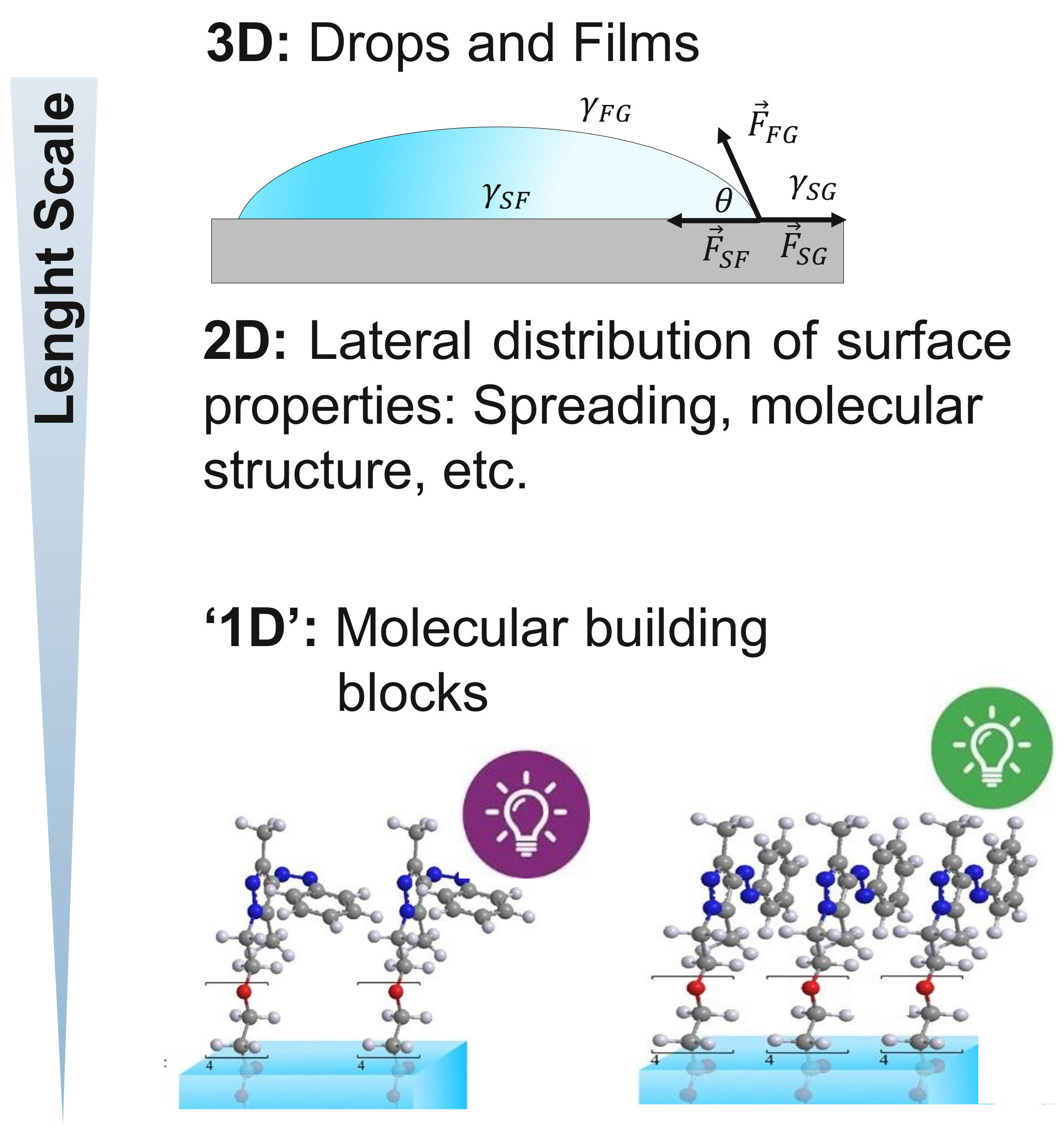
Schematic diagram of our hierarchical approach that uses structure-property relations from the molecular to the macroscopic. Prerequisite for this approach are characterization several length scales which can link dynamic changes of interfacial molecular structures to changes on larger length scales

Octadecanethiol self-assembled monolayer(SAM) on an Au surface with a drop of aqueous solution that contained arylazopyrazole photoswitchable surfactants. Photographs of the drop shape and the results for the contact angle are shown as a function of time and light irradiation (UV vs green).
The Braunschweig group uses the combined knowledge from experiments and analysis at all length scales of soft matter materials to control and improve materials properties in a targeted way. For that purpose, knowledge on molecular assemblies and their physical chemistry at interfaces is of great importance and can be used to tailor material properties from the nano to the macroscopic scale through structure property relations. Interface controlled materials and processes are present in various different applications where they dominate both microscopic and macroscopic properties and functions. For that reason, it is our goal to increase the level of understanding on the chemistry of soft matter interfaces that are of importance for molecular self-assembly, bio interfaces, colloid science, catalysis and in nanotechnology. Over the years, our group has developed a strong expertise in both, method development and application of nonlinear optical spectroscopy such as sum-frequency generation (SFG) and second-harmonic scattering (SHS) to interfaces. In a SFG experiment for surface vibrational spectroscopy a visible and a tunable infrared laser beam are combined at the interface and the intensity of the resulting sum frequency signal is measured which can be used to identify molecular fingerprints of surface adsorbed species, their orientation and molecular order.
Die Forschungsschwerpunkte des Arbeitskreises Braunschweig befinden sich auf dem Gebiet der physikalischen Chemie von fluiden Grenzflächen und grenzflächenkontrollierten Materialien. Dabei verfolgen wir das Konzept, Materialeigenschaften und Prozesse durch die Steuerung von physikalischen und chemischen Eigenschaften einzelner molekularer Bausteine auf der Nanoskala bis zum makroskopisch sichtbaren Material entlang vieler Längenskalen zu kontrollieren und zu charakterisieren. Unsere Forschung stützt sich dabei auf die Anwendung moderner nichtlinearer optischer Laserspektroskopie mit ultrakurzen Laserpulsen. Insbesondere setzen wir die optische Frequenzverdopplung und die Summenfrequenz-Schwingungsspektroskopie (engl. Sum-Frequency Generation) ein. Die Spektroskopie wird in Kombination mit komplementären Methoden genutzt, um die molekulare Struktur und die physikochemischen Wechselwirkungen an Grenzflächen unter relevanten Bedingungen zu charakterisieren und Struktur-Eigenschafts-Beziehungen abzuleiten.
https://www.uni-muenster.de/Chemie.pc/forschung/braunschweig/
Related Publications:
- Gracía Rey N, Weißenborn E, Schulze-Zachau F, Gochev G, Braunschweig B Quantifying Double-Layer Potentials at Liquid-Gas Interfaces from Vibrational Sum-Frequency Generation. In: 'J. Phys. Chem. C 123 (2019), p. 1279-1286. doi: https://dx.doi.org/10.1021/acs.jpcc.8b10097
- Meltzer C, Yu H, Peukert W, Braunschweig B Molecular structure of octadecylphosphonic acids during their self-assembly on alpha-Al2O3(0001). In: 'Phys. Chem. Chem. Phys. 20 (2018), p. 19382-19389. doi: https://dx.doi.org/10.1039/C8CP02391C
- Paul J., Meltzer C., Braunschweig B., Peukert W. Lubrication of Individual Microcontacts by a Self-Assembled Alkyl Phosphonic Acid Monolayer on α-Al2O3(0001) . In: 'Langmuir 32 (2016), No. - 33, p. 8298-8306. doi: https://dx.doi.org/10.1021/acs.langmuir.6b01933
- Memory effects in polymer brushes showing co-nonsolvency effects
Simon Schubotz, Christian Honnigfort, Saghar Nazari, Andreas Fery, Jens-Uwe Sommer, Petra Uhlmann, Björn Braunschweig and Günter K. Auernhammer.
Adv. Colloid Interface Sci. 294, 102442 (2021) https://dx.doi.org/10.1016/j.cis.2021.102442 - Dynamic wetting of photoresponsive arylazopyrazole monolayers is controlled by the molecular kinetics of the monolayer
Christian Honnigfort, Leon Topp, Natalia García Rey, Andreas Heuer and Björn Braunschweig.
J. Am. Chem. Soc. (2022) https://dx.doi.org/10.1021/jacs.1c12832
Dynamic advancing and receding contact angles of adaptive surfaces - H.-J. Butt, R. Berger
Dynamic advancing and receding contact angles on adaptive surfaces
Dynamische Fortschreit- und Rückzugskontaktwinkel auf adaptiven Oberflächen
PIs:
Hans-Jürgen Butt, Prof. Dr. (Direktor), Max-Planck-Institut für Polymerforschung Mainz, Ackermannweg 10, 55128 Mainz
Rüdiger Berger, Dr. (Gruppenleiter), Max-Planck-Institut für Polymerforschung Mainz
PhD students:
Xiaomei Li
Benjamin Leibauer
Surface adaptation has been put forward to be one cause for the velocity dependence of advancing and receding contact angles, even at low slide velocity. By considering a dry-to-wet and a wet-to-dry relaxation process, we had proposed a model, which is able to explain these dynamic contact angles (Langmuir 2018, 34, 11292). The aim of our project is to experimentally verify the model and explore, how applicable it is. In the first funding period, we built an inclined plane setup to measure advancing and receding contact angles versus velocity for water drops up to 1 m/s. We synthesized a random poly(styrene/acrylic acid) copolymer PS/AA and demonstrated that for water drops on PS/AA films, advancing-contact-angle-versus-velocity-curves can indeed be fitted with the model. The fit revealed relaxation times < 2 ms of the polymer at the surface. However, we are still missing independent measurements of the dry-to-wet relaxation times, which would be required for full validation of the model.
The aim for the second funding period is to investigate polymer surfaces, where we can independently measure the relaxation time of the dry-to-wet and the wet-to-dry transitions. Then, recorded advancing-contact-angle-versus-velocity-dependencies can be validated independently using our model. Therefore, we plan to synthesize three types of polymer brushes: (1) PS and poly(2-vinylpyridine) (PVP) binary brush films, (2) pH-responsive poly(N,N-dimethyl aminoethyl methacrylate) (PDMAEMA) brushes and (3) different block copolymer layers. For series of drops sliding on an adaptive surface we predicted a focusing effect. It is induced by partial adaptation caused by the first drop sliding along the surface. This drop leaves behind a lane of increased surface energy and we expect that subsequent drops will then slide along the same lane. Our aim is to verify this hypothesis.
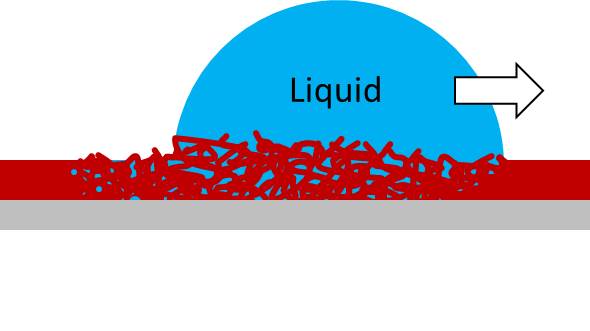
Schematic of a liquid drop on an adaptive polymer surface
Group: Experimental physics of interfaces. We study the structure and dynamics of soft matter interfaces. Intrinsically this involves small objects due to their high interface-to-volume ratio. The scientific aim is a simple, comprehensive quantitative description of phenomena, which is based on fundamental physical laws. Major research topics are: dynamics of wetting, super liquid-repellency, surface forces, crystallization in in confined space, colloids and granular matter, photoresponsive materials. The methods used include scanning probe techniques, confocal microscopy, fluorescence correlation spectroscopy, light and X-ray scattering. To expand the range of length and time scales accessible, new methods are continuously developed to excess shorter time and smaller length scales. Our goal is to solve fundamental questions, with the perspective of future applications. “Understanding” not only implies quantitative prediction. Full understanding implies being able to make new materials and devices based on this understanding.
Die Adaption von Oberflächen ist eine Ursache für die Geschwindigkeitsabhängigkeit der fortschreitenden und zurückweichenden Kontaktwinkel. Dies gilt auch für niedrige Kontaktliniengeschwindigkeiten. Wir haben ein Modell vorgeschlagen, das diese dynamischen Kontaktwinkel erklärt (Langmuir 2018, 34, 11292). Ziel unseres Projekts ist es, das Modell experimentell zu verifizieren und zu untersuchen, wie gut es die experimentellen Daten erklären kann. In der ersten Förderperiode haben wir einen experimentellen Aufbau entwickelt, um die vorrückenden und zurückweichenden Kontaktwinkel in Abhängigkeit von der Geschwindigkeit für Wassertropfen bis zu 1 m/s zu messen. Wir haben ein statistisches Poly(styrol/Acrylsäure)-Kopolymer (PS/AA) synthetisiert. Mit Hilfe der Messungen haben wir gezeigt, dass für Wassertropfen auf PS/AA-Filmen die geschwindigkeitsabhängigen, fortschreitenden Kontaktwinkel mit dem Modell erklärt werden können. Hierbei erhielten wir Relaxationszeiten der Polymer-Oberfläche < 2 ms. Wünschenswerte wäre aber noch unabhängige Messungen dieser Relaxationszeiten, um unser Modell vollständig zu validieren.
Das Ziel für die zweite Förderperiode ist es, Polymeroberflächen zu untersuchen, an denen wir die Relaxationszeiten des Trocken-Nass- und des Nass-Trocken-Übergangs bei Benetzung und Entnetzung zusätzlich mit einer unabhängigen Methode messen können. Dann können die gemessenen geschwindigkeitsabhängigen Fortschreit-Kontaktwinkel unabhängig von unserem Experiment mit unserem Modell validiert werden. Daher planen wir die Synthese von verschiedenen an Oberflächen gehefteten Polymerbürsten: (1) Bürstenfilme aus Mischungen von PS und Poly(2-vinylpyridin) (PVP), (2) Bürstenfilme die auf den pH-Wert des Tropfens reagieren (Poly(N,N-dimethylaminoethylmeth¬acrylat) und (3) Bürstenfilm aus Blockcopolymeren. Die partielle Adaption von Oberflächen durch die Benetzung eines ersten, gleitenden Tropfens sollte einen Fokussierungseffekt für nachfolgende Tropfen erzeugen. Der erste Tropfen hinterlässt eine Spur erhöhter Oberflächenenergie. Wir gehen davon aus, dass nachfolgende Tropfen dann entlang derselben Spur gleiten werden. Unser Ziel ist es, diese Hypothese zu verifizieren und zu quantifizieren.
Abteilung: Physik der Grenzflächen. Die Gruppe befasst sich mit der Physik von Grenzflächen in weicher Materie. Ziel ist nicht nur ein besseres Verständnis der Gleichgewichtseigenschaften, sondern auch der Dynamik bei Prozessen. Wichtige Schwerpunkte sind Oberflächenkräften und Benetzung, insbesondere von superhydrophoben und superoleophoen Oberflächen. Weitere Themen sind: Benetzung durch komplexe Flüssigkeiten, photosensitive Materialien, Kristallisation in confinement, Phononics und Photonics, granulare Materie. Als Verfahren setzen wir u. a. Rasterkraftmikroskopie, konfokale Lichtmikroskopie einschließlich Fluoreszenz-Korrelationsmikroskopie und Röntgen- sowie Lichtstreuung ein. Um die zugänglichen Längenskalen zu verkleinern und die Zeitskalen zu verkürzen, werden ständig neue Methoden entwickelt bzw. Methoden verbessert. Unser Ziel ist ein besseres Verständnis der Grundlagen. Wir sind aber offen für mögliche Anwendungen.
https://www.mpip-mainz.mpg.de/en/butt
Publications related to the project:
- Xiaomei Li, Simon Silge, Alexander Saal, Gunnar Kircher, Kaloian Koynov, Rüdiger Berger, Hans-Jürgen Butt, Adaptation of a styrene-acrylic acid copolymer surface to water, Langmuir 37, 1571-1577 (2021).
- Hans-Jürgen Butt, Jie Liu, Kaloian Koynov, Benedikt Straub, Chirag Hinduja, Ilia Roismann, Rüdiger Berger, Xiaomei Li, Doris Vollmer, Werner Steffen, Michael Kappl, Contact angle hysteresis, Current Opinion in Colloid and Interface Science 2022, accepted.
- William S.Y. Wong, Lukas Hauer, Abhinav Naga, Anke Kaltbeitzel, Philipp Baumli, Rüdiger Berger, Maria D‘Acunzi, Doris Vollmer, and Hans-Jürgen Butt, Adaptive Wetting of Polydimethylsiloxane, Langmuir, 36, 7236 - 7245 (2020).
- Alexander Saal, Patrick M. Seiler, Daniel Rettenmaier, Michael Ade, Ilia V. Roisman, Rüdiger Berger, Hans-Jürgen Butt, and Cameron Tropea, Shuffling gait motion of an aerodynamically driven wall-bound drop, Phys. Rev. Fluids 5, 094006 (2021).
- Hans-Jürgen Butt und Rüdiger Berger, Treffen sich drei Phasen..., Physik Journal 20 Nr. 4, 29-34 (2021).
- Florian Geyer, Patrick M. Seiler, Doris Vollmer, Rüdiger Berger, Wie sich Tropfen bewegen, Physik in Unserer Zeit 2, 90-96 (2019).
Modelling of spreading, imbibition and evaporation of liquids on structured or porous deformable substrates - T. Gambaryan-Roisman
PI: Apl. Prof. Dr. Sc. Tatiana Gambaryan-Roisman, Institute for Technical Thermodynamics, TU Darmstadt, Alarich-Weiss-Straße 10, 64287, Darmstadt
PhD student: Nikolai Kubochkin, Institute for Technical Thermodynamics, TU Darmstadt, Alarich-Weiss-Straße 10, 64287, Darmstadt
In nature as well as in numerous industrial processes, the surfaces brought in contact with liquids are not atomically smooth but rather possess roughness. They can contain pores and cracks at different scales or be structured. The wetting phenomena manifest themselves at different scales on such surfaces. Being applicable at the macroscale and microscale, the classical theory of capillarity is broken down at the smaller scales when accounting for the intermolecular (surface) forces is paramount. Moreover, many surfaces are deformable. They
can be exemplified by gels and rubbers, cells and biological tissues as well as by materials containing fibers and thin sheets. The softness is known to change the wetting statics and dynamics on such surfaces.
The main objective of the project in the first three-year term was development of theoretical and numerical models for spreading, imbibition and evaporation of liquids on structured and porous substrates, taking into account the deformability of the substrate and of elements of the porous structure. The theoretical and numerical works revealed the peculiarities of the wetting, evaporation and imbibition at the nanoscale and the effect of the surface forces on these phenomena. Particularly, we have shown that the equilibrium contact angle of a sessile droplet depends drastically on the droplet size, when the droplet height is within the range of the surface force action. When the droplet spreads over an elastic substrate, the evolution of the wetting ridge shape was found to be defined by the surface forces.
We have also demonstrated that accounting for the surface forces can lead to existence of the steady states of rivulets in open wedge channels, even when the liquid-gas interface is concave. Such steady states cannot be predicted within the approach suggested by the classical capillarity. The presence of the liquid in the open wedge channels with thin deformable walls leads to their deformation.
In the second funding period, the developed models will be extended to include the Shuttleworth effect and the model of soft solids with structured surface and non-uniform distribution of mechanical properties. The model of wetting at nanoscale will be applied for the description of liquid imbibition and evaporation in nanopores. The model of capillary-induced deformation of corner geometries with thin walls will be used for description of the imbibition kinetics coupled with the thin wall deformation and liquid evaporation. The results of the previous work packages will be used for the development of the global transport model with the effective transport coefficients determined by the geometry, surface chemistry and mechanical properties of the substrate, the properties of the liquid and the thermodynamic conditions.
https://www.ttd.tu-darmstadt.de/ttd/leute/people_ttd_details_1882.en.jsp
https://www.ttd.tu-darmstadt.de/ttd/leute/people_ttd_details_183296.en.jsp
Project-related publications:
- Kubochkin, N., Gambaryan-Roisman, T., Wetting at nanoscale: Effect of surface forces and droplet size. Phys. Rev. Fluids, 6(9), 093603 (2021)
- Kubochkin, N., Gambaryan-Roisman, T., Surface force-mediated dynamics of droplets spreading over wetting films. Phys. Fluids, 33(12), 122107 (2021)
- Kubochkin, N., Gambaryan-Roisman, T., Capillary-Driven Flow in Corner Geometries. Curr. Opin. Colloid Interface Sci. (accepted)
- Kubochkin, N., Gambaryan-Roisman, T., Edge Wetting: Steady State of Rivulets in Wedges. arXiv:2201.04420, https://arxiv.org/abs/2201.04420 (2022).
- Ghillani, N., Heinz, M., Gambaryan-Roisman, T., Capillary rise and evaporation of a liquid in a corner between a plane and a cylinder: A model of imbibition into a nanofiber mat coating, Eur. Phys. J. Spec. Top., 229, 1799 (2020)

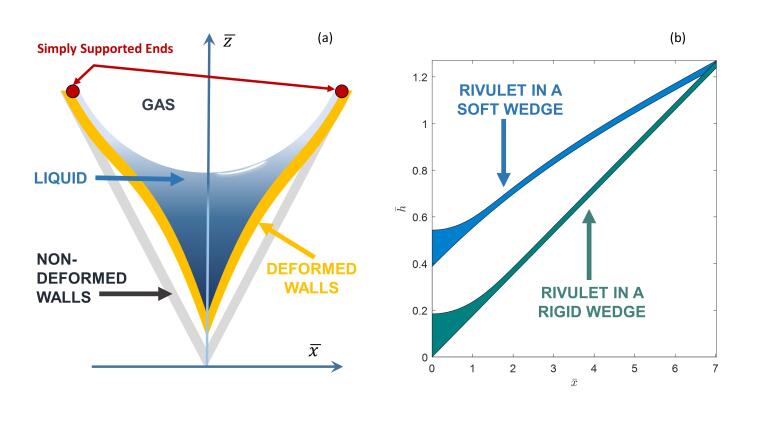

Liquids on switchable pre-structured substrates - from microscopic to mesoscopic models - S.V. Gurevich, A. Heuer
PD Dr. Svetlana Gurevich Institute for Theoretical Physics, University of Münster, Wilhelm-Klemm-Str. 9, 48149 Münster, Germany
Prof. Dr. Andreas Heuer Institute for Physical Chemistry, University of Münster, Correnstrasse 28/30, 48149 Münster, Germany
M.Sc. Leon Topp Institute for Physical Chemistry, University of Münster, Correnstrasse 28/30, 48149 Münster, Germany
M.Sc. Moritz Teigelkötter Institute for Theoretical Physics, University of Münster, Wilhelm-Klemm-Str. 9, 48149 Münster, Germany
Das Benetzungsverhalten von Flüssigkeiten auf Oberflächen ist abhängig von der Stärke der Wechselwirkung zwischen der Flüssigkeit und dem Substrat. Je stärker dabei die Wechselwirkung zwischen dem Substrat und den Flüssigkeitspartikeln ist, desto geringer ist zum Beispiel der Kontaktwinkel zwischen der Oberfläche und einem sich darauf befindlichen Tropfen. In diesem Projekt soll nun das Verhalten von Tropfen auf schaltbaren Substraten theoretisch untersucht werden. Dazu verändern wir die Wechselwirkung zwischen den Flüssigkeitspartikeln und dem Substrat durch eine einmalige Änderung oder periodisch mit variierenden Frequenzen. Dabei untersuchen wir verschiedene Eigenschaften des Tropfens. Von besonderem Interesse ist das Verhalten von Tropfen auf schaltbaren vorstrukturierten Oberflächen. So möchten wir herausfinden, wie sich ein Tropfen auf einem hydrophilen Streifen als auch auf zwei nahe beieinander liegenden Streifen bei verschiedenen Schaltfrequenzen verhält. Als Simulationsmethoden kommen sowohl teilchenbasierte Techniken (Molekulardynamik und Monte Carlo Verfahren), als auch Kontinuumsmodelle zum Einsatz.
The wetting behavior of liquids on surfaces depends on the interaction strength between the liquid and the substrate. The higher the interaction strength between the substrate and particles of the liquid, the lower is the contact angle between the surface and the droplet placed on it. In this project the behavior of droplets on switchable surface should be investigated theoretically. For this purpose we change the interaction strength between the liquid particles and the substrate once or periodically with different frequencies. While doing so we observe different properties of the droplet. The behavior of droplets on switchable prestructured surfaces is of special interest. Thus, we want to study the behavior of a drop on a hydrophilic stripes and also on two close-by stripes for different switching frequencies. As simulation methods we use both particle based techniques (Molecular Dynamic and Monte Carlo) and continuum modelling.
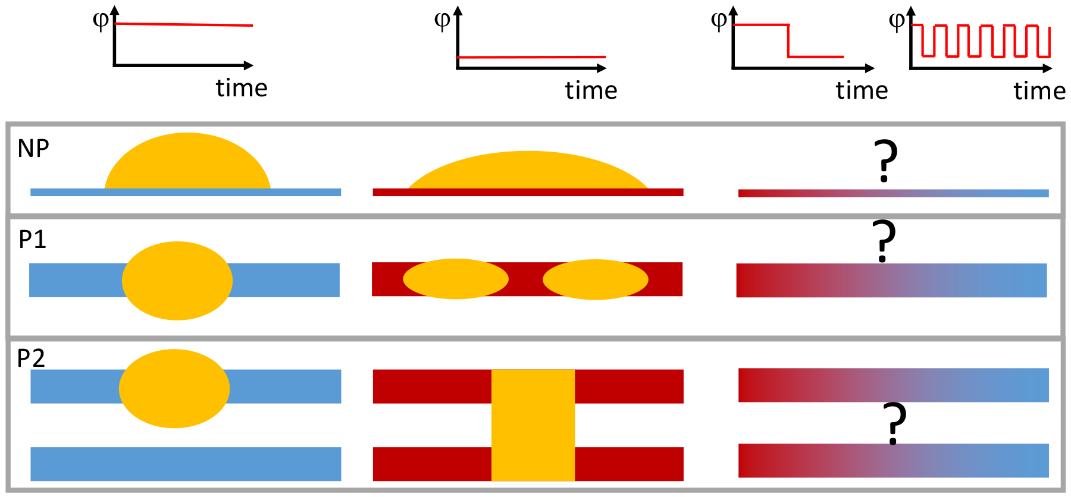
Unsere Arbeitsgruppe arbeitet breit gefächert auf dem Gebiet der theoretischen physikalischen Chemie. So werden Themenfelder der Biochemie und der Benetzbarkeit von Oberflächen ebenso erforscht wie Gläser und Elektrolyte. Dazu kommen verschiedene Simulationstechniken zum Einsatz. Es werden sowohl Molekulardynamik als auch Monte Carlo und Dichtefunktionaltheorie Simulationen verwendet.
Our research group works in a broad range of theoretical physical chemistry. We face topics in the area of biophysics and wetting of surfaces as well as glass-forming liquids and electrolytes. For this purpose, we use different simulation methods like Molecular Dynamic and Monte Carlo as well as density functional methods.
https://www.uni-muenster.de/Chemie.pc/forschung/heuer/gruppe/index.html
Das wissenschaftliche Ziel der Arbeitsgruppe Selbstorganisation und Komplexität ist es, universelle Eigenschaften von Nichtgleichgewichtssystemen mit theoretischen und numerischen Methoden zu erforschen. Von besonderem Interesse sind dabei Methoden der nichtlinearen Dynamik wie Bifurkations- und Chaostheorie, welche mit Methoden der statistischen Physik und der Theorie stochastischer Prozesse kombiniert werden. Aktuelle Forschungsgebiete sind die raumzeitliche Strukturbildung in selbstassemblierenden Systemen, die raumzeitliche Dynamik in Systemen der Nichtlinearen Optik, die Grenzflächendynamik komplexer Fluide und weicher Materie, die Dynamik von Phasenübergängen und Wachstumsprozesson und die kollektive Dynamik von Biofilmen, Bakterienkolonien, Geweben und Mikroschwimmern.
The scientific aim of the working group on Self-Organization and Complexity is to explore universal properties of non-equilibrium systems with theoretical and numerical methods. Of considerable interest are methods of nonlinear dynamics like bifurcation theory, chaos theory combined with methods of statistical physics and the theory of stochastic processes. Current areas of research are the spatio-temporal pattern formation in self-assembling systems and its control, the spatio-temporal dynamics of optical nonlinear system, the interface dynamics for complex liquids and soft and active matter, the dynamics of phase transitions and growth processes and the collective dynamics of biofilms, bacterial colonies, tissues and micro-swimmers.
https://www.uni-muenster.de/Physik.TP/research/thiele/
References:
- Lied, Fabian et al. (2012). “Different growth regimes on prepatterned surfaces: Consistent evidence from simulations and experiments”. In: The Journal of Chemical Physics 136.2, p. 024704. doi: 10.1063/1.3676257.
- Buller, Oleg et al. (2018). “Boundary-induced nucleation control: a theoretical perspective”. In: Physical Chemistry Chemical Physics 20.5 (5), pp. 3752–3760. doi: 10.1039/C7CP02348K.
- Honisch, Christoph et al. (2015). “Instabilities of Layers of Deposited Molecules on Chemically Stripe Patterned Substrates: Ridges versus Drops”. In: Langmuir 31.38, pp. 10618–10631. doi: 10.1021/acs.langmuir.5b02407.
- Tewes, Walter et al. (2017). “Comparing kinetic Monte Carlo and thin-film modeling of transversal instabilities of ridges on patterned substrates”. In: The Journal of Chemical Physics 146.9, p. 094704. doi: 10.1063/1.4977739.
- Multiscale perspective on wetting on switchable substrates: mapping between microscopic and mesoscopic models
Moritz Stieneker, Leon Topp, Svetlana Gurevich and Andreas Heuer.
arXiv preprint arXiv:2108.00641 (2021) - Wetting behavior of droplets on switchable substrates: A theoretical perspective
Moritz Stieneker, Leon Topp, Svetlana Gurevich and Andreas Heuer.
arXiv preprint arXiv:2203.13719 (2022)
Drop Impact on Soft (Adaptive) Substrates - K. Harth
Tropfen auf weichen, deformierbaren Oberflächen findet man in vielen Szenarien der Biologie, Medizin und zunehmend auch in Anwendungen. Beispielsweise kann Verformbarkeit die Aufprallresultate und die Bewegung von Flüssigkeiten massiv beeinflussen. In einigen Fällen können auch dünne flexible Schichten auf harten Substraten und / oder sowie strukturierte Oberflächen vorliegen, sodass eine komplexe mikroskopische Struktur zu betrachten ist. Während die Forschung zu statischen oder langsam bewegten Kontaktlinien auf solchen deformierbaren Oberflächen bereits fortgeschritten ist, sind qualitative und quantitative Messungen bei schneller Kontaktlinienbewegung noch rar. In diesem Rahmen bilden aufprallende Tropfen eine spezielle Problemstellung, hier wechselwirken deformierbare Oberflächen hydrodynamisch mit der bewegten Flüssigkeit selbst. Bekannt ist zum Beispiel, dass durch weiche Oberflächen das Splashing unterdrückt werden kann. Die bisherigen Experimente befassen sich hier allerdings lediglich mit Messungen der Tropfendynamik, die Deformationen des Substrates blieben weitgehend uncharakterisiert und wurden zumeist vernachlässigt. Zwei Studien des Tropfenaufpralls auf mikrometer-dünne Ölschichten [1,2] belegen allerdings schon hier wesentliche Deformationen des Substrates, weitere Experimente belegen Auswirkungen solcher dünnen Schichten auf die gesamte Tropfendynamik. Aufgrund der teils mikroskopischen, dennoch für das Gesamtbild wesentlichen, Deformationen des Substrats auf kurzen Zeitskalen, stellt deren Messung eine besondere Herausforderung dar. Teils sind zusätzlich weniger mikrometer-dicke Gasschichten involviert, deren Unterschiede zu harten, homogenen Substraten aber ebenfalls nur in Kombination mit der Dynamik des Substrates verstanden werden können.
Im Rahmen dieses Projektes soll die gekoppelte Dynamik von Kontaktlinien, ggfs. Gasschichten und Kontaktbildung (siehe Bild), und einer dünnen Schicht eines deformierbaren Substrates quantitativ mittels optischer Methoden ermittelt werden. Hierzu werden verschiedene Techniken, z.B. schnelle konfokale Mikroskopie, Interferometrie und Totalreflexionsbildgebung mit konventionellen Seitenansichten und in Vogelperspektive kombiniert. Der Fokus und die Herausforderung liegt in schnellen Prozessen, die in teils wenigen Dutzend bis hunderten Mikrosekunden abgeschlossen sind. Auf Basis der gewonnenen Erkenntnisse lassen sich fundierte Modelle zum Verständnis der Kontaktliniendynamik aufbauen. Die Modellierung, insbesondere numerische Simulationen und detaillierte mathematische Modelle, werden in Zusammenarbeit mit anderen Gruppen des SPP erarbeitet. Zudem sind Untersuchungen neuartiger adaptiver Materialien, welche Ihre Grenzflächeneigenschaften gezielt verändern können, geplant.
Diverse scenarios in biology, medical sciences, and increasing also in technical applications involve droplets on soft, deformable substrates. Substrate flexibility and deformability can essentially alter the outcome of drop impact, but can also be exploited for directional transport of liquids. In some cases, thin flexible layers of rigid substrates and / or structured sub-layers are exploited, so that even a spatially inhomogeneous base structure needs to be considered. While research made quite some progress regarding static or slowly-moving contact lines over the last 10 to 15 years, quantitative and even qualitative measurements of substrate deformations in interaction with rapidly moving contact lines are almost not present to date. In that context, impacting droplets represent a particular field of interest. For example, it is known that soft layers can suppress splashing, and do affect drop retraction, but the (fluid) mechanical problem is by far not solved. Previous experiments have been largely limited to the dynamics of the drop liquid, the substrate deformations being uncharacterized and mostly even neglected. Impact on micrometers-thin oil films already indicates substantial substrate deformations [1,2], and additional experiments show clear evidence of an altered drop behavior. While deformations are microscopic, they are often still essential – however, they are hard to measure, in particular during fast processes which last only few dozens or hundreds of microseconds. A second challenge are sub-micrometric gas layers entrained between the drop liquid and the deformed substrate. The overall dynamics can only be understood, if all parts of the system are simultaneously characterized.
Characterizing the coupled dynamics of a deformable substrate in interaction with rapid contact line motion and / or impacting drops experimentally, using optical methods, is the focus of the present project. This also includes entrained gas layers and the process of contact formation, an example is shown below. Methods include high-speed confocal microscopy (self-built setup), interferometry and total internal reflection imaging in combination with conventional side and top view videos. The focus, and at the same moment the challenge, lies in the required high spatial and temporal resolution of the measurements. From the new experimental insight, one may construct better and physics-based models of contact line dynamics, applicable to diverse and general cases. Other groups in the SPP are involved with numerical simulations of some special situations and the derivation of rather complex mathematical models. In addition to that, investigations of novel adaptive and switchable substrates without deformability are planned.
References:
[1] S. Lakshman, W. Tewes, K. Harth, J. H. Snoeijer, D. Lohse, Deformation and relaxation of viscous thin films under bouncing drops J. Fluid Mech. 920 A3 (2021)
[2] H. Y. Lo, Y. Liu, L. Xu, Mechanism of Contact between a Droplet and an Atomically Smooth Substrate, Phys. Rev. X 7 021036 (2017)
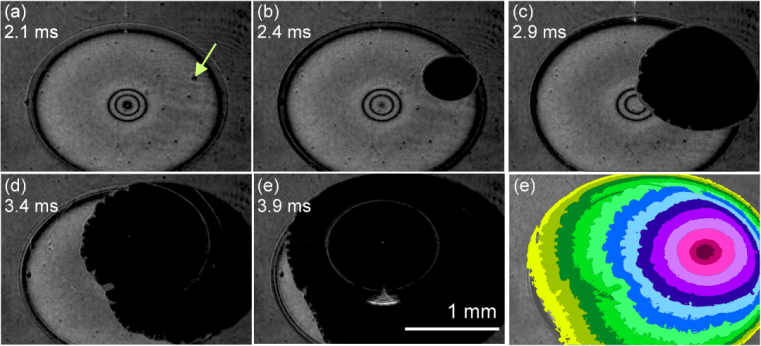
Colloidal assembly as a tool for adaptive and switchable interfaces - J. Harting
Colloidal assembly as a tool for adaptive and switchable interfaces
Dynamische Benetzung flexibler, adaptiver und schaltbarer Oberflächen
PI: Prof. Dr. Jens Harting
PhD student: Thomas Scheel
Helmholtz Institute Erlangen-Nürnberg for Renewable Energy (IEK-11)
Forschungszentrum Jülich
Fürther Str. 248
D-90429 Nürnberg, Germany
We aim at a fundamental understanding of dynamic wetting and dewetting processes on flexible, adaptive and even switchable substrates by means of lattice Boltzmann simulations and simple analytical models. We propose strategies utilizing colloidal assembly at fluid interfaces to generate “substrates” with complex geometrical and wetting properties. We will base on recent advances in the synthesis and control of colloids which led to the availability of particles with highly specific features such as well-defined shapes and surface properties together with the ability to manipulate them by external forces and fields.
Mit Hilfe von Gitter-Boltzmann-Simulationen und einfachen analytischen Modellen wollen wir ein grundlegendes Verständnis dynamischer Be- und Entnetzungsprozesse auf flexiblen, adaptiven und sogar schaltbaren Substraten erlangen. Wir schlagen Strategien vor, bei denen kolloidale Anordnungen an Fluidgrenzflächen und in externen Feldern verwendet werden, um „Substrate“ mit komplexen Geometrien und Benetzungseigenschaften zu erzeugen. Hierbei stützen wir uns auf jüngste Fortschritte in der Synthese und Handhabung von Kolloiden, welche Partikel mit hochspezifischen Oberflächeneigenschaften verfügbar gemacht haben.
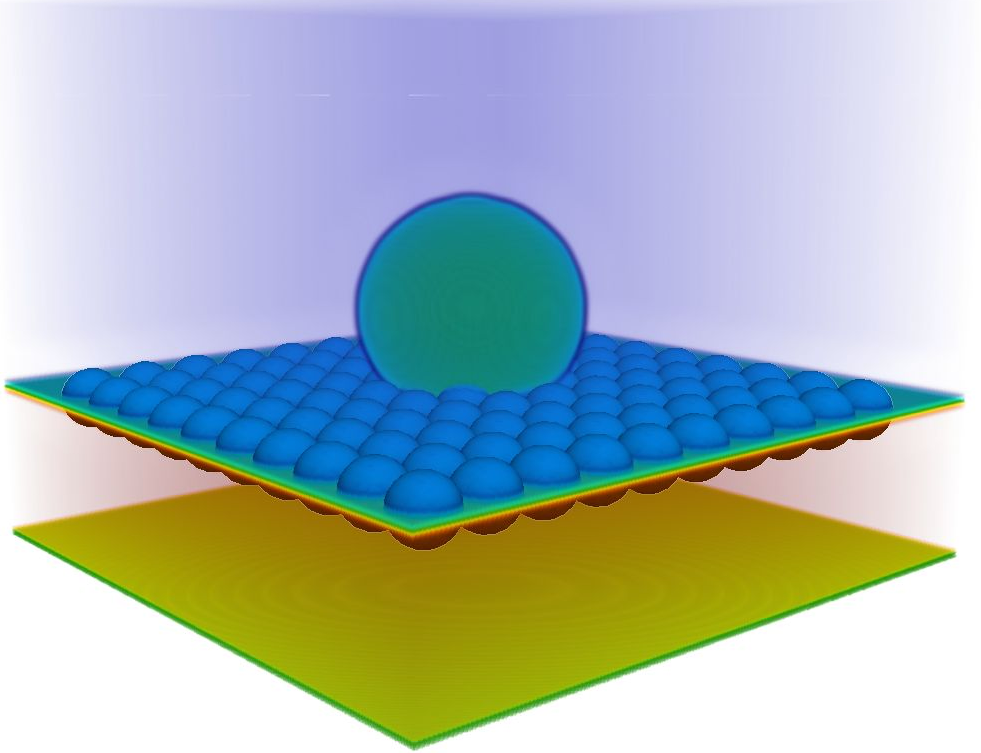
Computer simulation of a droplet sitting on a
substrate made of magnetic Janus particles
which are adsorbed to a fluid-fluid interface.
The research focus of the research department of “Dynamics of Complex Fluids and Interfaces” at the Helmholtz Institute Erlangen-Nürnberg for Renewable Energy (HI ERN) is the development and application of computer simulation methods in fluid dynamics and soft matter physics, with special emphasis on the dynamics of systems involving multiple fluid and solid phases, interfaces, and complex interactions due to e.g. capillary forces, external fields, or confinement. The research ranges from fundamental questions on the rheology and phase behavior of complex fluids in general to applications in microfluidics, coating, printing, transport in porous media, or colloidal self-assembly.
Der Forschungsschwerpunkt der Abteilung „Dynamik komplexer Fluide und Grenzflächen“ am Helmholtz-Institut Erlangen-Nürnberg für Erneuerbare Energien liegt in der Entwicklung und Anwendung von Simulations- und Modellierungstechniken in Strömungsmechanik und der Physik der weichen Materie. Dies beinhaltet Mehrphasenströmungen und Suspensionen mit komplexen Wechselwirkungen, wie bspw. kapillare Kräfte, externe Felder, etc.. Die Forschungsthemen umfassen grundlegende Fragen zur Rheologie und dem Phasenverhalten komplexer Flüssigkeiten, mit Anwendungen in der Mikrofluidik, dem Transport in porösen Medien oder kolloidaler Selbstorganisation.
http://www.hi-ern.de/hi-ern/CompFlu/node.html
Direct assembly of magnetic Janus particles at a sessile droplet interface, Q. Xie, G. B. Davies, J. Harting, ACS Nano 11, 11232-11239 (2017)
Controlled capillary assembly of magnetic Janus particles at fluid-fluid Interfaces, Q. Xie, G. B. Davies, J. Harting, Soft Matter 12, 6566 - 6574 (2016)
Tunable dipolar capillary deformations for magnetic Janus particles at fluid-fluid interfaces, Q. Xie, G. B. Davies, F. Günther, J. Harting, Soft Matter 11, 3581-3588 (2015)
Multiphase lattice Boltzmann simulations for porous media applications - a review, H. Liu, Q. Kang, C. R. Leonardi, S. Schmieschek, A. Narvaez Salazar, B. D. Jones, J. R. Williams,A. J. Valocchi, J. Harting, Computational Geosciences 20, 777-805 (2016)
Numerical simulations of complex fluid-fluid interface dynamics, T. Krüger, S. Frijters, F. Günther, B. Kaoui, J. Harting, European Physical Journal Special Topics 222, Number 1, 177-198 (2013)
Evaluation of droplet shape and three-phase contact line movement on dynamically switchable spiropyran surfaces - D. Helmer
Untersuchung von Tropfenform und Dynamic der Dreiphasenkontaktlinie auf dynamisch schaltbaren Spiropyran Oberflächen
Evaluation of droplet shape and three-phase contact line movement on dynamically switchable spiropyran surfaces
PI: Dorothea Helmer, group leader of Materials Structuring and Surface Chemistry at the Chair of process technology
University of Freiburg, Department of Microsystems Engineering IMTEK, Chair of Process Technology, Georges-Köhler-Allee 103, 79110 Freiburg
We are interested understanding the wetting behaviour of droplets on surfaces, to enable the design of new materials. We aim for the characterization and synthesis of structured surfaces with special wetting properties such as soft gels, SLIPS and superrepellent surfaces.
Publications
D. Helmer, N. Keller, F. Kotz, F. Stolz, C. Greiner, T. M. Nargang, K. Sachsenheimer, B. E. Rapp: Transparent, abrasion-insensitive superhydrophobic coatings for real-world applications, Nature Scientific Reports, 7, 1, 15078.
N. Keller, J. Bruchmann, T. Sollich, C. Richter, R. Thelen, F. Kotz, T. Schwartz, D. Helmer, B. E. Rapp: "Study of biofilm growth on slippery liquid infused porous surfaces (SLIPS) made from Fluoropor", ACS Applied Materials & Interfaces, 11, 4, 4480-4487, 2019
T. M. Nargang, R. Dierkes, J. Bruchmann, N. Keller, K. Sachsenheimer, C. Lee-Thedieck, F. Kotz, D. Helmer and B. E. Rapp: "Photolithographic structuring of soft, extremely foldable and autoclavable hydrophobic barriers in paper", Analytical Methods, 10, 4028-4035, 2018
In der Natur sind viele Benetzungsprozesse durch die dynamischen Eigenschaften der Oberfläche charakterisiert. In diesem Projekt soll der Einfluss der Substratdynamik auf das Verhalten von Tropfen auf Oberflächen untersucht werden. Ein besonderer Fokus liegt hierbei auf der Untersuchung der Dreiphasenkontaktlinie. Im Rahmen des Projektes werden dynamische, zwischen unterschiedlichen Zuständen der Oberflächenenergie (hydrophil/hydrophob) oder Viskosität schaltbare Substrate auf Spiropyran-Basis hergestellt und auf ihre Schaltbarkeit hin untersucht. Die Verwendung von Spiropyranen bietet den Vorteil, dass hydrophobe Bereiche farblos erscheinen, während geschaltete, hydrophile Bereiche violett erscheinen, was die optische Untersuchung erleichtert. Die Schaltung der Polymere erfolgt durch Licht oder mechanische Einwirkung. Mit einer Messplattform bestehend aus zwei Hochgeschwindigkeitskameras in Kombination mit einer maskenlosen Lithographieanlage zur Generierung von Schaltungsmustern wird die Tropfendynamik während und nach dem Schaltvorgang untersucht.
In nature, many wetting processes are characterized by the dynamics of the solid substrate. In this project, the influence of substrate dynamics on the behaviour of droplets will be investigated. The main focus of this project is the analysis of the three-phase contact line. In the course of this project dynamic substrates which can be switched between different states of surface energy (hydrophilic/hydrophobic) based on spiropyrans will be generated and analysed in terms of their switching properties. Spiropyran surfaces are advantageous because the switch is directly visible due to a colour change from colourless (hydrophobic) to an intense magenta colouring (hydrophilic). Switching of the substrates is induced by light or by mechanical force. An imaging platform consisting of two highspeed cameras in combination with a maskless lithography setup for the generation of switching patterns is used for analysing the droplets during and after the switch. Droplet shape and movement dynamics in dependence of the switching patterns underneath the three-phase contact line will be investigated.
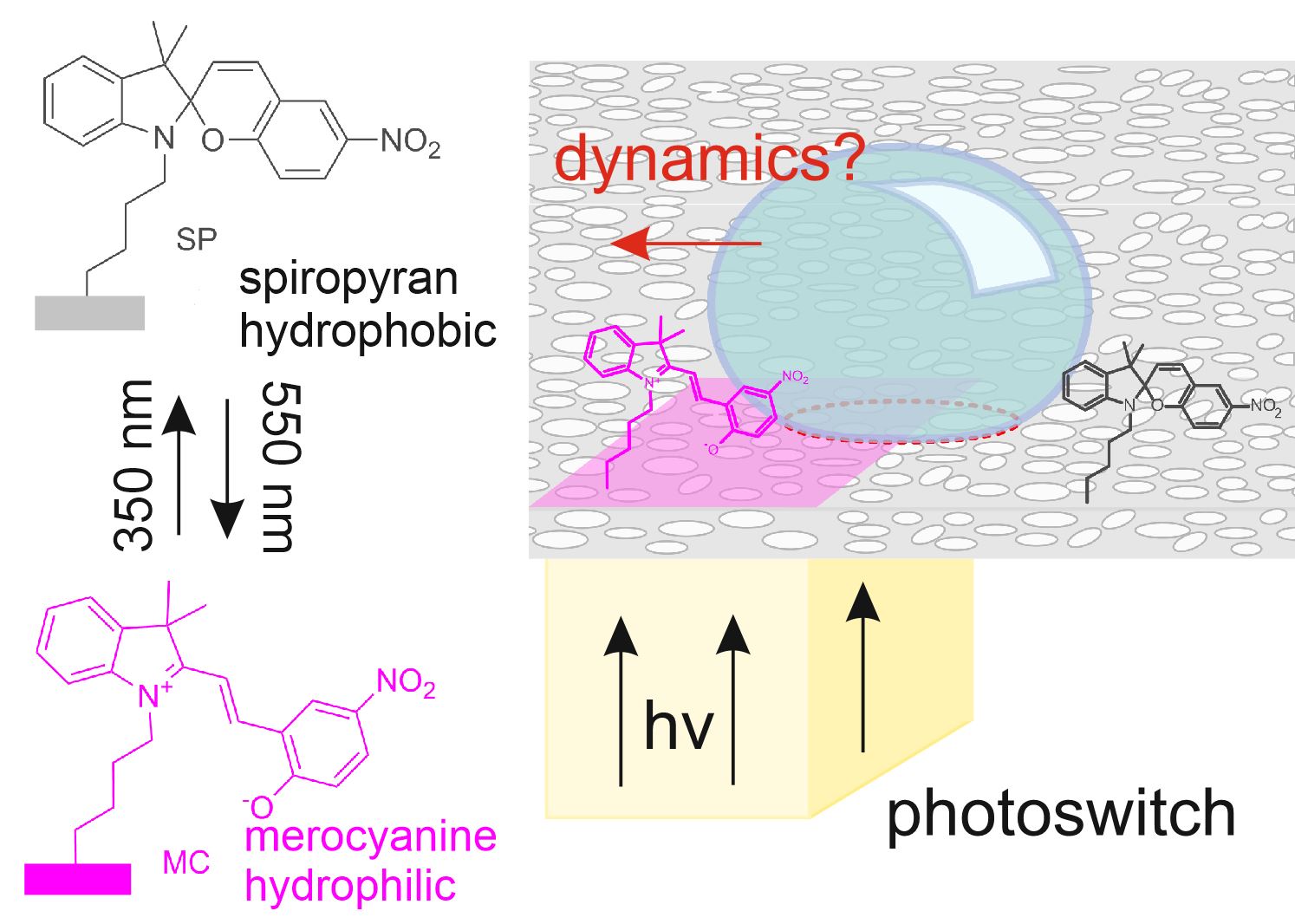
Droplet dynamics induced by the spiropyran photoswitch.
During the change in wetting properties the droplet dynamics are observed.
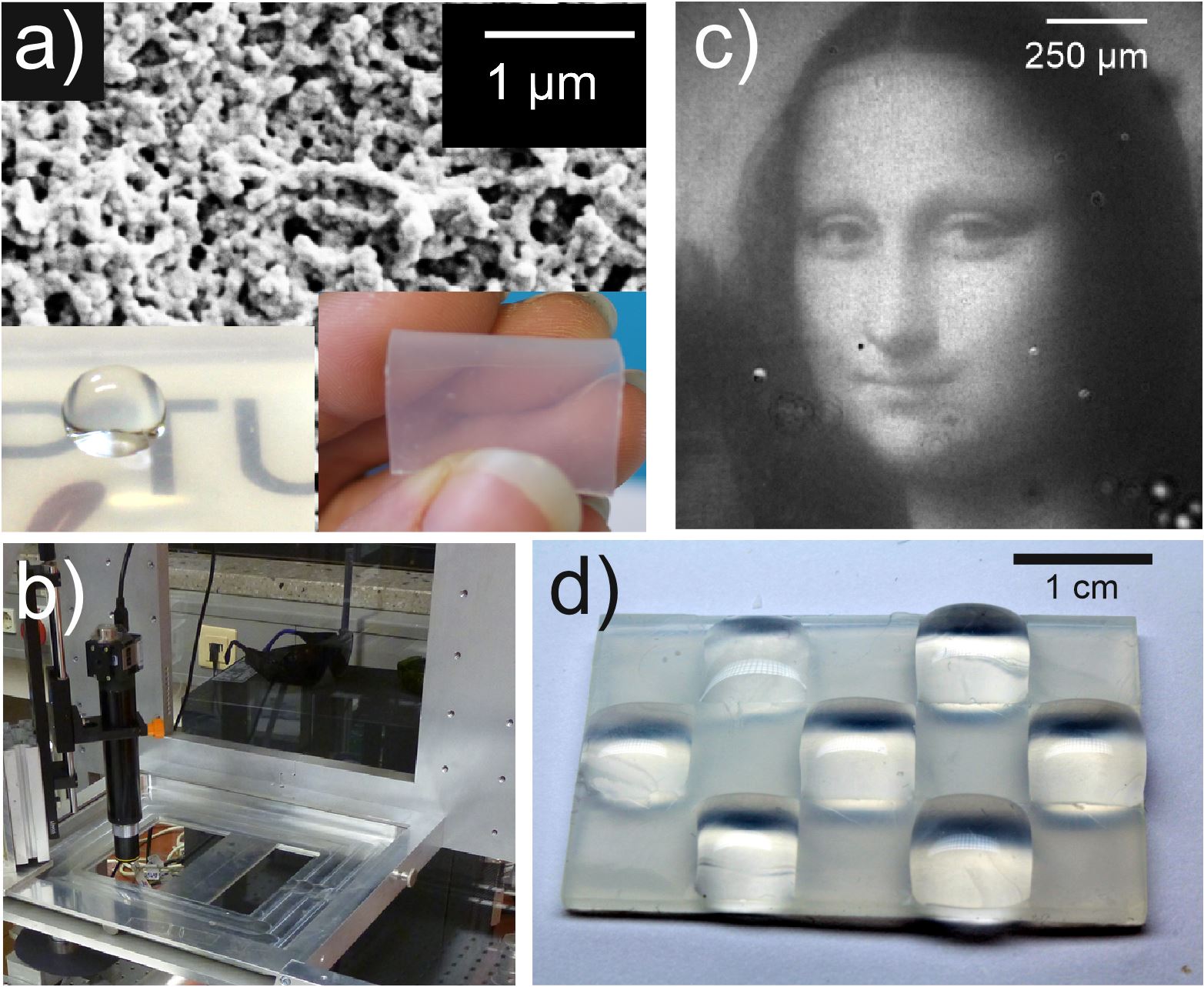
Expertise of the group in superhydrophobic polymers and surface patterns.
a) superrepellent materials,
b) highly precise photoswitching by a maskless
projection lithography system (Waldbaur et al., Small, 8, 10, 1570-1578, 2012)
that creates c) precise grayscale patterns on surfaces,
d) materials with alternating wetting properties.
Dynamic Electrowetting at Nanoporous Surfaces: Switchable Spreading, Imbibition, and Elastocapillarity - P. Huber
Dynamic Electrowetting at Nanoporous Surfaces: Switchable Spreading, Imbibition, and ElastocapillarityDynamische Elektrobenetzung an Nanoporösen Oberflächen: Schaltbare Tropfenspreitung, Imbibition und Elastokapillarität
Prof. Dr. Patrick Huber, Technische Universität Hamburg
Eva Nasserie (Master student), Technische Universität Hamburg
Elektrisch leitfähige Substrate, wie nanoporöse Metalle und Halbleiter, erlauben eine Kontrolle von Benetzungsenergien von Elektrolyten durch elektrische Felder. Dadurch ist es möglich, Tropfenformen und die Spreitdynamik von Flüssigkeitsfilmen auf Oberflächen zu kontrollieren. Auch das Befüllen des Porenraums mit Flüssigkeit ist über elektrisch steuerbare Krümmungen der Flüssigkeitsmenisken im Porenraum einer externen Kontrolle zugänglich und damit prinzipiell schaltbar. Weiterhin führen die enormen Laplace-Drücke, wie sie typischerweise in nanoporösen Medien in Anwesenheit von Flüssigkeiten auftreten, zu merklichen Deformationen der porösen Festkörper und damit im Falle von Elektrobenetzung zu einer potentialabhängigen Kopplung der Kapillarität der Flüssigkeit mit der Elastizität des Festkörpers, also elektrisch schaltbarer Elastokapillarität. Das komplexe Wechselspiel dieser Phänomenologien (Tropfenformdynamik, Infiltrationsdynamik und Deformationsverhalten) ist bis heute kaum erforscht. In diesem Projekt soll unter kontrollierten äußeren elektrischen Potentialen die Benetzungsdynamik von wässrigen Elektrolyten und die damit eng verknüpfte Deformationskinetik an maßgeschneiderten Oberflächen, die von parallelen zylindrischen Nanoporen durchzogen sind, experimentell erforscht werden.
Electrically conductive substrates, such as surfaces of nanoporous metals and semiconductors allow one to control the wetting energies of electrolytes by electrical potentials. Thereby, it is possible to tune droplet shape and liquid spreading dynamics at surfaces, however also the imbibition into the porous surface is under external control via electrical potential-dependent curvatures of the liquid menisci within the nanopores. Moreover, the enormous Laplace pressures and fluid-solid interfacial stresses, typical of nanopore-confined liquids, induce noticeable deformations of the porous solids, and thus result in the case of electrowetting in a potential-dependent coupling of liquid capillarity with solid elasticity, i.e. electrically switchable elastocapillarity. The complex interplay of these phenomenologies (droplet shape dynamics, imbibition and deformation behaviour) have been barely explored to date. Here, it is proposed to explore experimentally the wetting dynamics of aqueous electrolytes at tailored, single-crystalline silicon surfaces traversed by a parallel array of tubular nanopores along with the intimately related elastic deformation of the solids under electrical potential control of the solid-liquid interfacial tension. Both direct and electrowetting with dielectric oxide layers at the nanopore surfaces shall be studied. The existence of precursor films, droplet spreading and imbibition dynamics as well as the deformation on the microscopic (atomic silicon lattice) and macroscopic (substrate) scale will be scrutinized by time-dependent droplet shape analysis, opto-fluidic interferometry, dilatometry and synchrotron-based in-situ x-ray diffraction under variation of the mean pore diameter and porosity of the surface. The experiments shall be analysed in close cooperation with projects in this priority program focusing on computational modelling and mesoscopic phenomenological theories for liquid spreading, imbibition and elastocapillarity at planar and porous surfaces. The overarching objective of this project is a fundamental, predictive understanding of electrically switchable static and dynamic wetting at nanoporous surfaces.
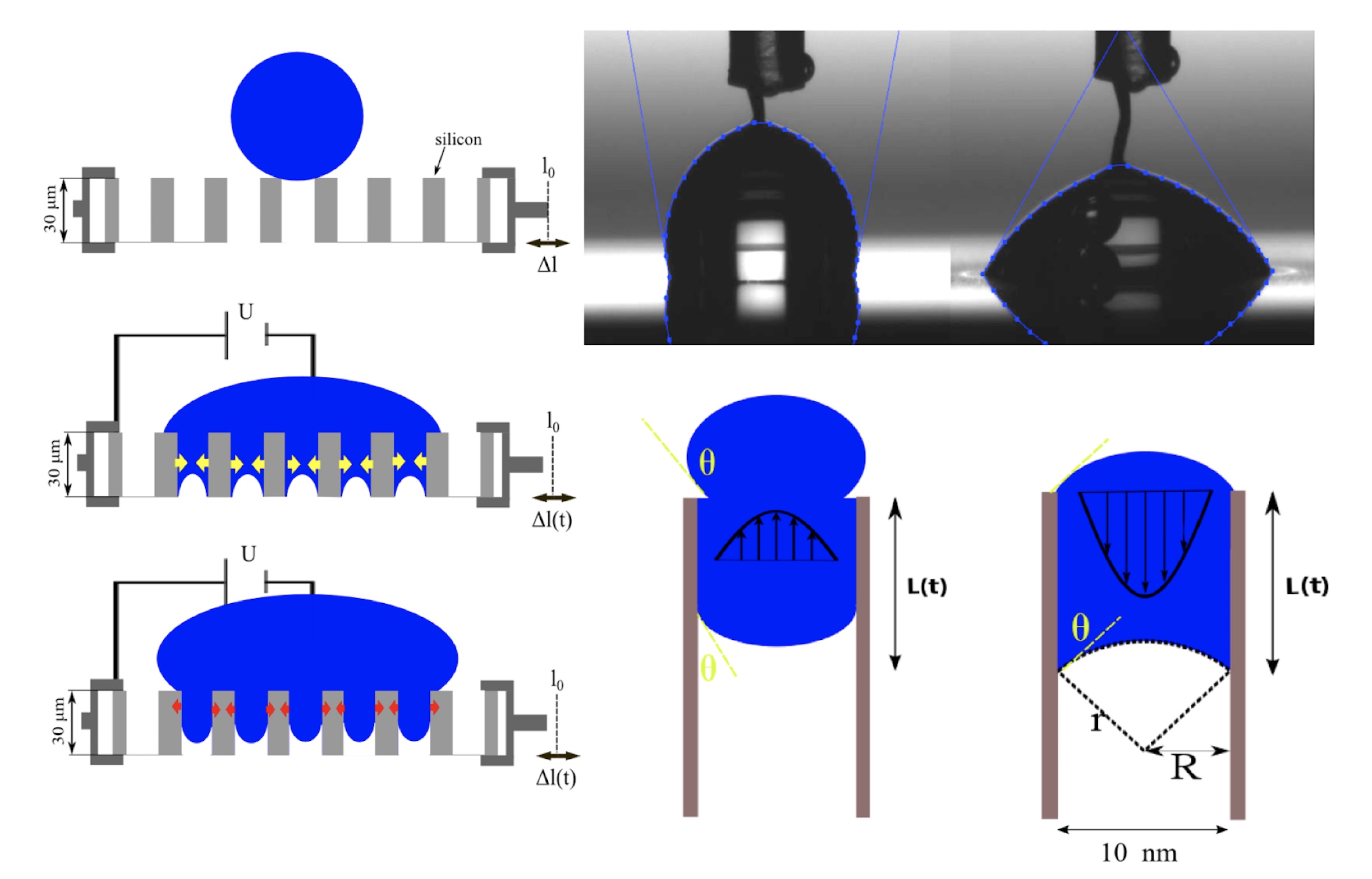
Schematische Seitenansicht eines Experiments zur Elektrobenetzung an einer nanoporösen Festkörpermembran: (a) Cassie-Baxter Anfangszustand. (b) Wenzel-Zustand an der Oberfläche und in den Nanoporen. (c) Die Flüssigkeitsmenisken ziehen sich zurück, nachdem die Bedingungen für die Elektrobenetzung auf Θ(U) < 90◦ umgestellt wurde. Sowohl in (b) als auch in (d) führt der Laplace-Druck in der Flüssigkeit dynamisch zu Zugkräften an den Porenwänden und damit zu einer von der Fülldynamik abhängigen makroskopischen Deformation. Statisches Elektrobenetzungsexperiment mit einem wässrigen Elektrolyten auf nanoporösem Silizium:(d) Kein elektrisches Potential, Kontaktwinkel Θ = 101.3◦. (e) unter negativem elektrischem Potential Θ = 54.3°. (g) Veranschaulichung der dynamischen Benetzungssituation in einem einzelnen Nanokanal.
Schematic sideview on a dynamic electrowetting and elastocapillarity experiment at a model nanoporous solid membrane: (a) Initial Cassie-Baxter state. (b) Wenzel state at the macroscopic substrate surface and in the nanopores. (c)The nanopore menisci are receding after the electrowetting conditions have been switched to Θ(U) < 90◦ after an initial pore filling process. Both in (b) and(d) the Laplace pressure in the liquid result in a dynamic manner to traction forces at the pore walls and thus to a filling-dynamics dependent macroscopic deformation. Static electrowetting experiment with an aqueous electrolyte on nanoporous silicon:(d) No electrical potential, contact angle Θ = 101.3◦. (e) under negative electrical potential Θ = 54.3°. (g) for an illustration of the dynamic wetting situation in a single nanochannel.
Unsere Arbeitsgruppe beschäftigt sich mit der experimentellen Erforschung der Eigenschaften von kondensierter Materie in beschränkten Geometrien, wie sie an planaren Grenzflächen, aber auch in nanoporösen Festkörpern auftreten. Diese wissenschaftlichen Grundlagen dienen dazu, neue funktionale Materialien zu designen.
Our research focuses on how condensed matter behaves in spatially confined geometries, most prominently in nanoporous media, and on how to employ this fundamental knowledge for the design of advanced materials.
https://huberlab.wp.tuhh.de/index.php/en/research
L-G. Cencha, G. Dittrich, P. Huber, C. L. A. Berli, and R. Urteaga: Precursor film spreading during liquid imbibition in nanoporous photonic crystals
Physical Review Letters 125 (23), 234502 (2020). https://dx.doi.org/10.1103/physrevlett.125.234502
L-G. Cencha, P. Huber, M. Kappl, G. Floudas, M. Steinhart, C. L. A. Berli, and R. Urteaga: Nondestructive high-throughput screening of nanopore geometry in porous membranes by imbibition. Appl. Phys. Lett. 115, 113701 (2019). https://doi.org/10.1063/1.5119338
G. Y. Gor, P. Huber, and J. Weißmüller: Elastocapillarity in nanopores: Sorption strain from the actions of surface tension and surface stress. Physical Review Materials 2 086002 (2018). https://dx.doi.org/10.1103/PhysRevMaterials.2.086002
Y. Xue, J. Markmann, H. Duan, J. Weissmüller, P. Huber: Switchable Imbibition in Nanoporous Gold. Nature Communications 5, 4237(2014).
https://doi.org/10.1038/ncomms5237
G. Gor, P. Huber, N. Bernstein: Adsorption-induced deformation of nanoporous materials - A review. Applied Physics Reviews 4, 011303 (2017).
https://doi.org/10.1063/1.4975001
P. Huber: Soft matter in hard confinement: phase transition thermodynamics, structure, texture, diffusion and flow in nanoporous media
Journal of Physics: Condensed Matter 27, 103102 (2015). https://doi.org/10.1088/0953-8984/27/10/103102
Beitrag in Spektrum der Wissenschaft: Kapillarwirkung auf Knopfdruck (https://www.spektrum.de/news/kapillarwirkung-auf-knopfdruck/1305460)
Reconfigurable surfaces with switchable and adaptive wettability based on shape-changing polymers - L. Ionov
The interaction of liquids with structured surfaces can have different character - either topography can determine wetting if the surface structures are hard, or topography affects wetting and the droplet shape affects the surface topography if the elastic forces and surface tension are comparable with each other. Depending on the size of surface structures and their elastic modulus, either surfaces tension or elastic force can dominate – this transition from domination of elastic force to counteraction of elastic and surface tension force was studied in the first funding period. In particular, we developed a method for fabrication of surface structures with the shape of lamellae with high aspect ratio from polymers with switchable mechanical properties and shape memory behavior. Surface structures either could or could not adapt to the droplet shape depending on the state of the polymer, and we demonstrated that the wetting properties depend on the deformability of the surface structures. In the second funding period, we will make a step forward and develop new method for fabrication of structured surfaces with actively switchable topography and will investigate how counteraction of elastic force and surface tension will affect switching of topography and switching of wetting behavior. Advanced combination of 3D-printing and electrospinning – melt electrowriting will be used to print complex structures using reversibly swelling and two-way shape memory polymers. We will also develop new methodology for acquiring 3D shape of droplet and will use it for studying of wetting on surfaces with switchable topography. The experimental results obtained in this project will be validated by models developed in cooperation with other members of SPP 2171.
Die Interaktion von Flüssigkeiten mit strukturierten Oberflächen kann unterschiedlichen Charakter haben – entweder kann Topografie eine Benetzung feststellen, wenn die Oberflächenstrukturen fest sind, oder die Topografie beeinflusst die Benetzung und die Tröpfchenform beeinflusst die Oberflächentopografie, wenn die elastischen Kräfte sowie die Oberflächenspannung miteinander vergleichbar sind. Abhängig von der Größe der Oberflächenstrukturen und ihrem Elastizitätsmodul, können entweder Oberflächenspannung oder die elastische Kraft dominieren – dieser Übergang der Dominanz von elastischer Kraft zur Gegenwirkung von elastischer- und Oberflächenspannungskraft wurde in der ersten Förderperiode untersucht. Dabei haben wir insbesondere eine Methode zur Herstellung von Oberflächenstrukturen in Form von Lamellen mit hohem Aspektverhältnis aus Polymeren mit schaltbaren mechanischen Eigenschaften und Formgedächtnisverhalten entwickelt. Die Oberflächenstrukturen konnten sich, je nach Zustand des Polymers, entweder der Tröpfchenform anpassen oder nicht, zudem haben wir gezeigt, dass die Benetzungseigenschaften von der Verformbarkeit der Oberflächenstrukturen abhängen. In der zweiten Förderperiode werden wir einen Schritt weiter gehen und ein neues Verfahren zur Herstellung strukturierter Oberflächen mit aktiv schaltbarer Topografie entwickeln und dabei untersuchen, wie sich die Gegenwirkung von elastischer Kraft und Oberflächenspannung auf die Umschaltung der Topografie und des Benetzungsverhaltens auswirkt. Wir verwenden eine fortschrittliche Kombination aus 3D-Druck und Elektrospinnen – nämlich das Schmelzelektroschreiben, um komplexe Strukturen aus reversibel quellenden und Zwei-Wege-Formgedächtnispolymeren herzustellen. Des Weiteren werden wir eine neue Methodik zur Erlangung der 3D-Form der Tröpfchen entwickeln und diese zur Untersuchung der Benetzung von Oberflächen mit schaltbarer Topografie verwenden. Die experimentellen Ergebnisse dieses Projekts werden durch Modelle validiert, die in Zusammenarbeit mit anderen Mitgliedern des SPP 2171 entwickelt wurden.
Dynamics of Liquid-Liquid-Elastic Three Phase Lines - S. Karpitschka
PI: Stefan Karpitschka, MPI-DS, Göttingen
PhD Student: Hansol Jeon, MPI-DS, Göttingen
https://www.ds.mpg.de/dcf/karpitschka-group
The dynamical wetting of rigid surfaces is governed by a balance of capillary forces and viscous dissipation inside the liquid. On soft surfaces however, spreading dynamics typically stem from quite different physics. Capillary forces at the three phase line deform the soft solid into a sharp wetting ridge. A spreading motion of the liquid causes a dynamical change of this deformation. The associated dissipation in the solid, and not the viscous liquid flow, governs the spreading motion. Therefore, spreading rates can be decelerated by orders of magnitude as compared to rigid solids, an effect which is frequently called viscoelastic braking. Pioneering work has revealed a scaling relation between the dynamical wetting behavior and the frequency dependence of the loss modulus of the solid. Recently we have developed a first quantitative theory that goes beyond scaling relations and is thus capable of predicting spreading rates. This way we could also describe a regime at larger velocities in which experiments no longer obey the scaling laws but instead, the viscoelastic braking force saturates. For even larger velocities, the contact line motion becomes unsteady, resembling a stick-slip type of motion.
Current models fail to quantitatively predict spreading rates, dynamic angles, and stick slip motion. Several reasons are debated in literature, ranging from singular line forces due to bulk elasticity to strain or strain-rate dependent solid surface tension. In all cases, linear viscoelastic theory, which is limited to small surface inclinations, is compared to highly non-linear experimental situations. In this project we want to gain experimental access the regime of small slopes, using liquid-liquid-elastic three-phase lines. By systematically increasing the tractions exerted by the liquid-liquid interface, we will disentangle the various sources of nonlinear behavior.
Liquid-liquid phase separation is an ideal tool to provide tunable interfacial tensions without major changes to the chemical nature of the system. It also enables us to investigate liquid-liquid phase separation in contact with deformable surfaces. The wetting behavior of droplets on soft surfaces depends on the size of the droplet, especially for very small droplets. Further it is known that droplets on soft surfaces interact through an elastocapillary mechanism. These unique features of soft wetting might imply facilitated nucleation and altered coarsening pathways in liquid-liquid phase separation.
New results from our project indicate that, even for the moderate deformations of very shallow wetting ridges under the contact lines of low surface tension liquids, the Neumann construction fails to predict the apparent angles observed on the wetting ridges. That renders non-linear elastic and surface effects unlikely. However, in a collaboration with Jacco Snoeijer (U Twente, project "Ensembles of sitting and sliding drops on elastic media - experiment, simulation and theory"), we could demonstrate experimentally that a sharp fold in an elastic material, even about only a small angle, induces a logarithmic singularity in the solid pressure [1]. Thus, the extraction of a microscopic amount of liquid PDMS may occur also for shallow wetting ridges, which we would like to address in more detail in the future.
In a collaboration with Sebastian Aland (TU Freiberg, project "Efficient simulations of dynamic wetting of flexible substrates"), we could now simulate also the stick-slip motion during forced wetting of a soft, viscoelastic substrate, revealing the onset criterion and the role of the fluid in the re-pinning to a new wetting ridge [2].
[1] M. A. J. van Limbeek, M. H. Essink, A. Pandey, J. H. Snoeijer, and S. Karpitschka, "Pinning-induced
folding-unfolding asymmetry in adhesive creases", Phys. Rev. Lett. 127, 028001 (2021), https://dx.doi.org/10.1103/PhysRevLett.127.028001
[2] D. Mokbel, S. Aland, and S. Karpitschka. "Stick-Slip Contact Line Motion on Kelvin-Voigt Model Substrates". (submitted to EPL), preprint: https://arxiv.org/abs/2201.04189

Highly accurate numerical simulation of wetting, dewetting and fluid-splitting phenomena between elastic surfaces - F. Kummer
Highly accurate numerical simulation of wetting, dewetting and fluid-splitting phenomena between elastic surfaces
Hochgenaue numerische Simulation von Benetzung, Entnetzung und Flüssigkeitsteilung zwischen elastischen Oberflächen
PI: Kummer, Florian, Dr.-Ing.
Other members: Oberlack, Martin, Prof. Dr.-Ing. habil.
Beck, Lauritz, M.Sc.
Fachgebiet für Strömungsdynamik
Technische Universität Darmstadt
The purpose of this project is to provide highly accurate numerical simulations, based on the discontinuous Galerkin (DG) method,
for the simulation of the interaction of liquids with flexible substrates. This includes especially simulation of the wetting behavior of the flexible solid.
Such processes have many technically relevant applications, one of them being e.g. flexographic printing, where water-based ink
is applied onto an elastic surface and from there onto the subject to print.
The complex interaction between three phases (gas/liquid/flexible solid) as well as the dynamics of
the three-phase contact line require numerical methods, which are able to represent the underlying mathematical models with high precision in order
to gain exact knowledge about the hydrodynamic effects. The models, e.g. for contact line dynamics, usually contain singular terms, e.g. forces which
are only active on the 2D interface or the 1D contact line.
In the present project, the high precision required to capture the singular behavior is guaranteed through
a cut-cell DG (also called extended or unfitted DG) method where singular forces can be implemented without regularization, i.e. `smearing’ of jumps and Dirac-deltas.
The characteristic sharp representation of the interface between two phases is portrayed in Figure 1.
Ziel des Projekts ist die hochgenaue numerische Simulation der Interaktion von Flüssigkeiten mit Festkörpern auf Grundlage
der Diskontinuierlichen Galerkin Methode. Hierbei liegt der Schwerpunkt auf der Simulation des Benetzungsverhaltens von elastischen Festkörpern.
Solche Verfahren haben viele technisch relevante Anwendungen, darunter z.B. den Flexodruck, bei dem wasserbasierte Druckfarben auf
eine elastische Oberfläche und von dort auf das zu bedruckende Objekt aufgebracht werden.
Die komplexe Wechselwirkung zwischen drei Phasen (Gas/Flüssigkeit/Flexibler Festkörper) sowie die Dynamik
der dreiphasigen Kontaktlinie erfordern hochgenaue numerische Methoden um genaue Kenntnisse über die hydrodynamischen Effekte zu erlangen.
Da in der Regel singuläre Terme auftreten, müssen die Methoden in der Lage sein, die zugrundeliegenden mathematischen Modelle präzise darzustellen.
In der Kontaktliniendynamik treten zum Beispiel Kräfte auf, die nur an der 2D-Oberfläche oder der 1D-Kontaktlinie aktiv sind.
In diesem Projekt wird die hohe Präzision, die zur Erfassung des singulären Verhaltens erforderlich ist,
durch eine cut-cell DG (auch Extended oder unfitted DG genannt) Methode gewährleistet, bei der singuläre
Kräfte ohne Regularisierung implementiert werden können, d.h. „Verschmieren“ von Sprüngen und die Verwendung von Dirac-Deltas.
Die charakteristische scharfe Darstellung der Oberfläche zwischen zwei Phasen wird in Abbildung 2 dargestellt.

Cut-cell DG-Simulation of a droplet sitting on a simple surface, in 2D as well as in 3D. Portrayed by a red line, the liquid-gas interface is represented sharply.
As visible on the left, the implementation also supports adaptive mesh refinement.
Cut-cell DG-Simulation eines Tropfens auf einer einfachen Oberfläche in 2D und 3D. Die Oberfläche des Tropfens, als rote Linie dargestellt, wird scharf dargestellt.
Das implementierte Verfahren unterstützt adaptive mesh refinement.
One of the questions we consider in detail is: Are the standard model equations capable of a correct reproduction of an impact event and initial wetting?
See the elementary setup in Figure 2 for example, where the following occurs presumably: Firstly,
the fluid and the solid interface cross over in between two time steps.
Secondly, after the topology has changed the contact line model will introduce strong forces; since the contact angle,
initially, is large. To investigate if these artifacts destroy the validity of the model equation, we observe properties such as:
- flow profiles in the droplet
- substrate deformation together with stress profiles
- general information on internal fields which are not visible for measurements
Eine der Fragestellungen, die näher untersucht werden soll, ist, ob die standard Modelle in der Lage sind einen Tropfenzusammenstoß und eine Oberflächenbenetzung korrekt zu reproduzieren.
Siehe Abbildung 2 für ein Beispiel, in dem folgende Probleme auftreten können:
1) Flüßigkeit und Festkörper überschneiden sich zwischen zwei Zeitschnitten.
2) Nachdem sich die Topologie geändert hat, treten große Kräfte an der Kontaktlinie auf, da der Kontaktwinkel zu Beginn groß ist.
Um zu untersuchen, ob diese numerischen Artefakte die Validität des gewählten Modells annulieren, werden verschiedene Eigenschaften betrachtet, unter anderem:
- Geschwindigkeitsprofile im Tropfens
- Deformation des Festkörpers und Spannungsprofile
- Nicht-messbare Größen

Elementary experiment „Droplet impact“: a drop attached to a solid surface on the top is lowered
at a controlled rate onto a flexible substrate until contact is made.
Grundlegendes Experiment „Droplet impact“:
Ein Tropfen, der auf einer festen Fläche angebracht ist, wird mit einer kontrollierten Geschwindigkeit
abgesenkt, bis er eine flexible Basisplatte berührt.
The Chair of Fluid Dynamics is part of the Technische Universität Darmstadt.
Our research focuses on fluid mechanics disciplines such as turbulence, combustion, multiphase flows, environmental flows,
continuum mechanics and flow thermodynamics. We primarily employ and develop theoretical as well as numerical methods
in order to obtain deeper knowledge of flow physics which can be used for the development and improvement of mathematical models.
The numerical implementation of model equations and the application to both fundamental and applied problems is the final goal of our research.
Das Fachgebiet für Strömungsdynamik ist Teil der Technischen Universität Darmstadt.
Unsere Schwerpunkte liegen in verschiedenen Bereichen der Strömungsmechanik,
wie z. B. den Gebieten Turbulenzforschung, Verbrennungsforschung, Mehrphasen-Strömungen, umweltrelevanter Strömungen sowie allgemeiner Kontinuumsmechanik und Thermodynamik.
Insbesondere setzen wir analytische und numerische Methoden ein, um sowohl Grundlagenprobleme als auch praxisorientierte Problemstellungen zu untersuchen.
Ziel ist ein tieferes Verständnis der Strömungsphysik, aber insbesondere auch die Entwicklung und Verbesserung mathematischer Modellgleichungen und numerischer Methoden.
Die numerische Implementierung neuer Modellgleichungen und deren Anwendung auf grundlagen- und praxisorientierte Problemstellungen schließen die Forschungsaktivitäten ab.
https://www.fdy.tu-darmstadt.de/fdy/fdy_home/home.en.jsp
BoSSS Framework https://github.com/FDYdarmstadt/BoSSS
F. Kummer, “Extended discontinuous Galerkin methods for two-phase flows: the spatial discretization”, Int. J. Numer. Methods Eng., vol. 109, no. 2, pp. 259–289, 2017.
T. Utz, F. Kummer and M. Oberlack: “Interface-preserving level-set reinitialization for DG-FEM”, Int. J. Numer. Methods Fluids, vol. 84, no. 4, pp. 183–198, 2017.
D. Krause and F. Kummer, “An incompressible immersed boundary solver for moving body flows using a cut cell discontinuous Galerkin method”, Computers & Fluids, vol. 153, pp. 118–129, 2017.
Pietro, Daniele Antonio Di, and Alexandre Ern. Mathematical Aspects of Discontinuous Galerkin Methods. Mathématiques et Applications. Berlin Heidelberg: Springer-Verlag, 2012. https://www.springer.com/gp/book/9783642229794.
Hesthaven, Jan S., and Tim Warburton. Nodal Discontinuous Galerkin Methods: Algorithms, Analysis, and Applications. Texts in Applied Mathematics. New York: Springer-Verlag, 2008. https://www.springer.com/de/book/9780387720654.
Wetting of bio-inspired, stimulus-responsive polymer surfaces by lipid vesicles - M. Müller, M. Tanaka
Benetzung von bio-inspirierten, Stimulus-reagierenden Polymeroberflächen durch Lipidvesikel
PI: Marcus Müller, Göttingen and Motomu Tanaka, Heidelberg
PhD student in Göttingen: Lucia Wesenberg
PhD student in Heidelberg: Felix Weißenfeld
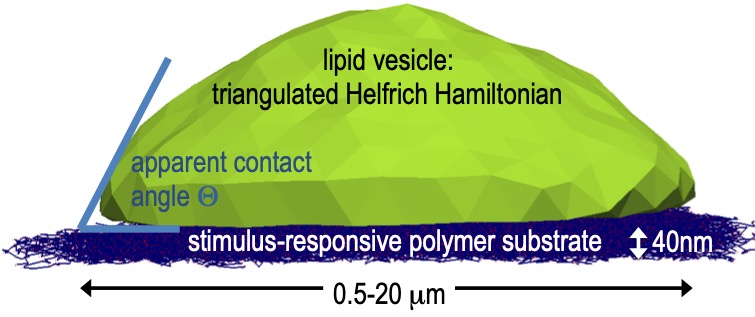

Analog to liquid drops, the shape of a vesicle is dictated by its enclosed volume, the membrane-substrate interaction, and the properties of the interface (membrane) between the interior and exterior. Unique to wetting by vesicles is the importance of the membrane’s intrinsic bending rigidity and the buoyancy of the enclosed liquid.
Weißenfeld and Tanaka have established a bio-inspired polymer brush platform, capable of switching the adhesion of vesicles. The vesicle shape is monitored by 3D confocal microscopy, and micro-interferometry provides complementary information about the local geometry of the edge of the brush-vesicle contact zone. Wesenberg and Müller have implemented a highly coarse-grained particle model of the switchable polymer brush and a triangulated Helfrich-Hamiltonian of the thin lipid membrane and have generalized the Helfrich description to include a finite-ranged interface potential and buoyancy.
Both teams will jointly investigate the dynamic change of vesicle shapes in response to a switch in interaction potential and the adaptation of the brush to the contact with a vesicle by time-dependent measurements of the vesicle geometry and study the size-dependence of thermodynamic forces and dissipation mechanisms.
Changes in the vesicle shape induced by (i) a collapse of the polymer brush, (ii) transport of positively charged lipids, binding to -COOH groups of the brush, (iii) wettability gradients, and (iv) time-dependent modulations of wettability will be studied.
http://www.theorie.physik.uni-goettingen.de/forschung/mm
References:
- Interface repulsion and lamellar structures in thin films of homopolymer blends due to thermal oscillations, L. Pigard and M. Müller, Phys. Rev. Lett. 122, 237801 (2019)
- Thermodynamically reversible paths of the first fusion intermediate reveal an important role for membrane anchors of fusion proteins, Y.G. Smirnova, H.J. Risselada, and M. Müller, PNAS 116, 2571 (2019)
- Engineering scale simulation of non-equilibrium network phases for battery electrolytes, L.Y. Schneider and M. Müller, Macromolecules 52, 2050 (2019)
- Directed self-assembly of block copolymers by chemical or topographical guiding patterns: Optimizing molecular architecture, thin-film properties, and kinetics, W.H. Li and M. Müller, Prog. Polym. Sci. 54-55, 47-75 (2016)
- Computational approaches for the dynamics of structure formation in self-assembling polymeric materials, M. Müller and J.J. de Pablo, Annual Reviews of Materials Research 43, 1-34 (2013)
Dynamic wetting phenomena in lattice models for nematic fluids liquid crystals near switchable substrate potentials - M. Oettel
PI: Martin Oettel, Eberhard Karls Universität Tübingen, Mathematisch-Naturwissenschaftliche Fakultät, Institut für Angewandte Physik, Auf der Morgenstelle 10, 72076 Tübingen
In diesem Projekt sollen Flüssigkristalle in der Nähe von schaltbaren Substraten mittels theoretischer Methoden und begleitender Simulationen untersucht werden. Von besonderem Interesse sind dabei das Verhalten bei Annäherung an einen Benetzungsübergang und bei Wechsel zwischen verschiedenen Benetzungszuständen.Als Modellsystem betrachten wir Stäbchen auf einem Gitter mit kurzreichweitigen Attraktionen.Wir haben klassische Dichtefunktionale für diese Modelle formuliert und werden diese verbessern sowie eine geeignete dynamische Dichtefunktionaltheorie ableiten.Benetzungsphasendiagramme für nematisch geordnete Filme (senkrecht oder parallel) und smektische Filme (mit möglichen Schichtungsübergängen) sollen berechnet werden. Von besonderem Interesse ist dann die Dynamik einer smektischen Schichtbildung und die Schaltdynamik zwischen nematischen Benetzungszuständen verschiedener Orienterung. Bei diesen Prozessen ist nur ein geringer Massentransport involviert und deswegen erwarten wir, dass eine mit der BrownschenDynamik verwandten Gitterdynamik die Prozesse gut beschreibt.Komplementäre Simulationen (großkanonische und kinetisches Monte Carlo) sollen durchgeführt werden, um die theoretischen Resultate zu validieren. In Kollaborationen mit experimentellen Gruppen sollen die Resultate zur Zeitabhängigkeit von smektischer Schichtbildung und bei Schaltprozessen zwischen verschiedenen nematischen Benetzungszuständen getestet werden.
Mathematical modeling and simulation of substrate-flow interaction using generalized gradient flows - D. Peschka
Mathematical modeling and simulation of substrate-flow interaction using generalized gradient flows
Mathematische Modellierung und Simulation der Wechselwirkung von Substraten mit Strömungen durch verallgemeinerte Gradientenflüsse
PI: Dirk Peschka, Weierstraß-Institut für Angewandte Analysis und Stochastik (WIAS)
This project considers the thermodynamically consistent treatment of flows over substrates whose dynamics is strongly coupled to the properties or the dynamics of this substrate. Methodically, the work concentrates on so-called gradient flows, i.e. model descriptions in which conservative forces are in optimal equilibrium with dissipative friction forces. While such descriptions are already well studied in the classical case, i.e. quadratic dissipation in volume, the aim of the present proposal is the systematic extension of these approaches to non-quadratic dissipations and the inclusion of free interfaces and contact lines. Especially for dewetting processes, the preliminary work of the PI has shown that the inclusion of such approaches is of essential importance.
Dieses Projekt befasst sich mit der thermodynamisch konsistenten Behandlung von Strömungen über Substraten, deren Dynamik stark an die Eigenschaften bzw. die Dynamik dieses Substrates gekoppelt ist. Methodisch konzentriert sich die Arbeit dabei auf sogenannte Gradientenflüsse, d.h. Modellbeschreibungen bei denen konservative Kräfte im optimalen Gleichgewicht mit dissipativen Reibungskräften stehen. Während solche Beschreibungen im klassischen Fall von quadratischer Dissipation im Volumen bereits relativ gut untersucht sind, ist das Ziel des vorliegenden Antrages die systematische Erweiterung dieser Ansätze auf nicht-quadratische Dissipationen mit Einbeziehung von Grenzflächen und Kontaktlinien. Insbesondere für Entnetzungsprozesse haben die Vorarbeiten des PI klar gezeigt, das die Einbeziehung solcher Ansätze von essentieller Bedeutung sind.
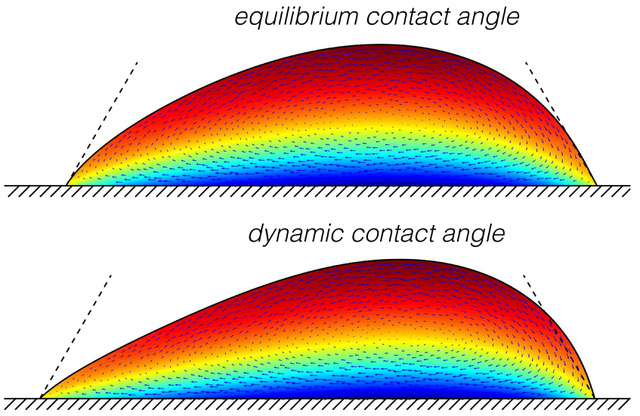
Moving droplet without and with dynamic contact angle via gradient
flow approach with contact line dissipation
Tropfen ohne und mit dynamischem Kontaktwinkel als in einer
Gradientenflussbeschreibung mit Kontaktliniendissipation

Dewetting and instability in a multiphase flow
Entnetzen und Instabilität in einer Mehrphasenströmung
My expertise is the mathematical modeling, model reduction and numerical treatment of nonlinear partial differential equations with moving boundaries via (thermodynamic) energetic variational modeling in the context of soft matter problems. In particular the consistent treatment of effects on interfaces and contact line is of particular interest. These problems are solved using the finite element method in combination with ALE methods for moving domains. Typical application fields are multiphase flows of viscous fluids, suspension flows, and charge transport in semiconductors.
Meine Expertise ist die mathematische Modellierung, Modellreduktion und numerische Behandlung nichtlinearer partieller Differentialgleichungen mit bewegten Gebieten und deren (thermodynamische) energetisch variationelle Beschreibung im Kontext von Problemen der kondensierten Materie. Insbesondere die konsequente Beschreibung von Phänomenen auf Grenzflächen und Kontaktlinien ist hier von besonderem Interesse. Diese Probleme werden mit der Finite-Elemente-Methode in Kombination mit ALE-Methoden für zeitabhängige Gebiete gelöst. Typische Anwendungsgebiete sind Mehrphasenströmungen von viskosen Flüssigkeiten, Suspensionsströmungen und Ladungsträgertransport in Halbleitern.
http://www.wias-berlin.de/people/peschka/spp2171/
[1] D. Peschka, S. Haefner, L. Marquant, K. Jacobs, A. Münch, and B. Wagner. Signatures of slip in dewetting polymer films. Proceedings of the National Academy of Sciences, 116(19):9275– 9284, 2019.
[2] D. Peschka. Variational approach to contact line dynamics for thin films. Physics of Fluids, 30(8):082115, 2018.
[3] D. Peschka, S. Bommer, S. Jachalski, R. Seemann, and B. Wagner. Impact of energy dissipation on interface shapes and on rates for dewetting from liquid substrates. Scientific Reports, 8(1):13295, 2018.
Adaptive Droplets Transport Through Coupled Flow Paths - T. Pfohl, U. Steiner
Adaptiver Tropfentransport durch gekoppelte Strömungswege
Adaptive Droplets Transport Through Coupled Flow Paths
Thomas Pfohl, Experimentelle Polymerphysik, Albert-Ludwigs-Universität Freiburg
Ullrich Steiner, Adolphe Merkle Institute, Université de Fribourg, Switzerland
PhD Student: Claas-Hendrik Stamp, Experimentelle Polymerphysik, Albert-Ludwigs-Universität Freiburg
Flexible und adaptive Materialsysteme mit ihrer Fähigkeit, dynamische Verformungen im Mikrobereich zu erzeugen, sind für eine Vielzahl spannender neuer Anwendungen relevant, wie z.B. im „Tissue-Engineering“, in der adaptiven Optik, flexiblen Elektronik und weichen Robotik. Ziel dieses Projekts ist es, den Transport von Flüssigkeiten und Tropfen in Kanälen zu untersuchen und zu analysieren, die durch flexible Membranen in mikrofluidischer Umgebung miteinander verbunden sind. Der vorgeschlagene mikrofluidische Aufbau für mehrphasige Strömungsexperimente, bestehend aus zwei durch eine dünne flexible Membran getrennten Transportkanälen, ermöglicht eine definierte Kontrolle der laminaren Strömung innerhalb der Transportkanäle, eine genaue Positionierung der Tropfen und die Möglichkeit, die Tropfenbewegungen und den Transport innerhalb der Kanäle zu analysieren und (Kreuz)-Korrelationen zwischen den Kanälen zu bestimmen. Aufgrund der sich bewegenden Tropfen und der auf beiden Seiten der Membran einwirkenden Strömungen reagiert die dünne elastische Membran spezifisch und verformt sich lokal auf die sich bewegenden Kontaktlinien der Tropfen, auf strömungsinduzierte Druckdifferenzen und scherinduzierte Effekte, was einen starken Einfluss auf die Transporteigenschaften in beiden Kanälen hat. Darüber hinaus wird mit Hilfe der Elektro-Hydrodynamik (EHD), die zur Unterstützung der strömungsinduzierten Instabilitäten der Membranen und der Rückkopplung in beiden Transportkanälen eingesetzt wird, die Kopplung und Querkommunikation der fließenden Materialien und der Informationstransport verstärkt und spezifisch gestaltet. Diese membraninduzierte Wechselwirkung wird verwendet, um die Tropfenbewegung und spezifische Strömungen innerhalb von fluidischen Transportwegen zu bewegen, anzupassen, steuern, verschieben und stoppen und darüber hinaus Strömungsmuster mit Anpassungs- und Selbstregulierungsfähigkeiten sowie langfristige logische Verbindungen und Operationen innerhalb der Transportnetze einzuführen.
Flexible and adaptive materials systems with their ability to create dynamic deformations on the microscale are relevant to a wide variety of exciting new applications such as in tissue engineering, adaptable optics, flexible electronics and soft robotics. The aim of this project is to study and analyze the transport of fluids and droplets in channels interfaced by flexible membranes in microfluidic environment. The proposed microfluidic setup for multiphase flow experiments, consisting of two transport channels separated by a thin flexible membrane, allows for a defined laminar flow-control within transport channels, an exact positioning of droplets and the opportunity to analyze droplet motion and transport within the channels and cross-correlation between the channels. Owing to the moving droplets and applied flow acting on both sides of the membrane, the thin elastic membrane will specifically respond and locally deform on the acting moving contact line, flow-induced pressure differences and shear-induced effects, having a strong impact on the transport properties in both channels. Moreover, using electro-hydrodynamics (EHD), which are going to be applied to interact with, stabilize and modify flow-induced instabilities of the membranes and the feedback in both transport channels, the coupling and cross-communication of the flowing materials and information transport will be amplified and specifically shaped. This membrane-initiated crosstalk will be used to move, adapt, govern, shift and stop droplet motion and specific flows within fluid transport routes and moreover to introduce flow patterns with adaption and self-regulation capabilities as well as on the long term logical links and operations within fluid transport networks.
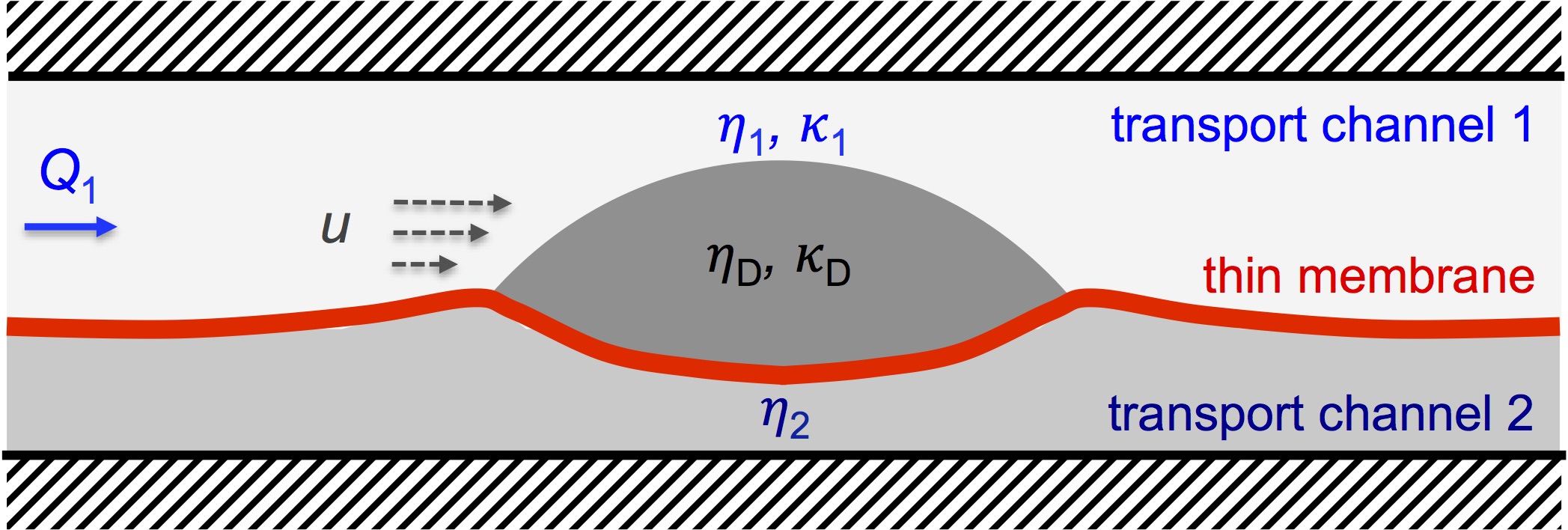
Schematic representation of the impact of drag on the motion of a fluid droplet in contact with a thin elastic membrane separating two transport channels.
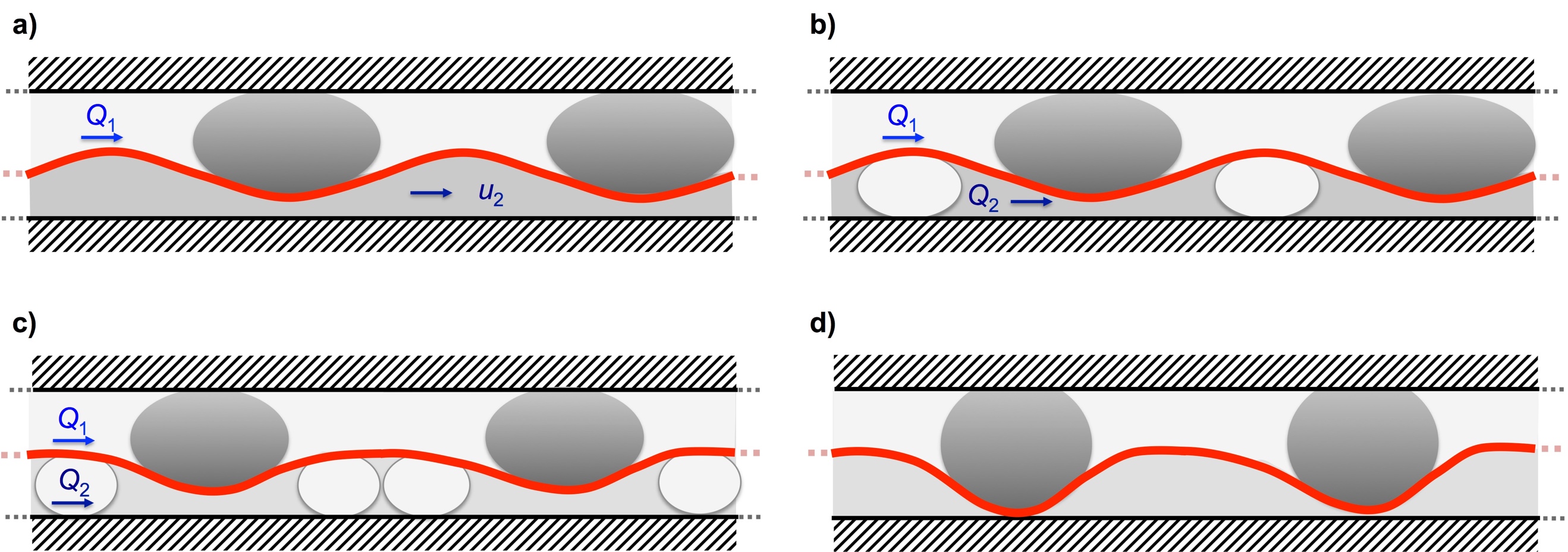
Schematics of coupled flows in our microfluidics systems. a) Droplet flow in upper channel induces pumping of fluid adjacent channel. b) Anti-correlated droplet flow in adjacent channels. c) Flow pattern shaping in adjacent channels. d) Flexible obstacles block flow in adjacent channel.

Control of segmented flow by a locally applied electric field. (a) The flow of a dielectric drop into the electric field triggers the instability, arresting the transport. The local triggering of a membrane instability can act as a peristaltic pump. (c) Applying an electric field across a laterally extended dielectric drop splits the drop into two.
https://www.polymerphysik.uni-freiburg.de/mitarbeiter-en/pfohl
M. A. Gerspach, N. Mojarad, D. Sharma, Y. Ekinci, T. Pfohl, Pneumatically controlled nanofluidic devices for contact-free trapping and manipulation of nanoparticles, Part. Part. Syst. Charact. 35, 1800161 (2018).
M. A. Gerspach, N. Mojarad, D. Sharma, T. Pfohl, Y. Ekinci, Soft electrostatic trapping in nanofluidics, Microsystems & Nanoengineering 3, 17051 (2017).
N. Strelnikova, M. Göllner, T. Pfohl, Direct observation of alternating stretch-coil and coil-stretch transitions of semiflexible polymers in microstructured flow, Macromol. Chem. Phys. 218, 1600474 (2017).
Dynamic wetting of self-assembled monolayers and polymer brushes functionalized with photoresponsive arylazopyrazoles - B.J. Ravoo
Dynamische Benetzung von selbstorganisierenden Monoschichten und Polymerbürsten mit photosteuerbaren Arylazopyrazolen
Dynamic wetting of self-assembled monolayers and polymer brushes functionalized with photoresponsive arylazopyrazoles
PI: Prof. Bart Jan Ravoo
PhD student: Niklas Arndt
Organic Chemistry Institute and Center for Soft Nanoscience
WWU Münster
Molekulare Photoschalter sind einzigartige Verbindungen die durch Bestrahlung mit Licht zwischen zwei stabilen Isomeren (Molekülformen) hin und her geschaltet werden können. Da die Isomere unterschiedliche Eigenschaften aufweisen, führt die Integration von molekularen Photoschaltern in Materialien und Beschichtungen zu makroskopischen Effekten wie lichtschaltbare Stabilität, Permeabilität und Benetzbarkeit. In diesem Projekt untersuchen wir eine neue Klasse von Photoschaltern für die Herstellung von Oberflächen mit lichtsteuerbarer Benetzbarkeit. Aufgrund eines optimierten Moleküldesigns soll der Photoschalter in selbstorganisierenden Monoschichten sowie in Polymernanoschichten eine verstärkte dynamische Benetzbarkeit bewirken.
Molecular photoswitches are a unique type of molecules that can be switched reversibly between two isomers (shapes) using irradiation with light. Since the two isomers of the molecular photoswitch have different properties, incorporation of photoswitches into materials and coatings can result in macroscopic effects such as photoswitchable stability, permeability, or wettability. In this project we will investigate a new type of molecular photoswitch to prepare surfaces with photoresponsive wettability. Due to optimized molecular design, the photoswitch can be self-assembled in monolayers or embedded in polymer nanofilms with enhanced dynamic wettability.
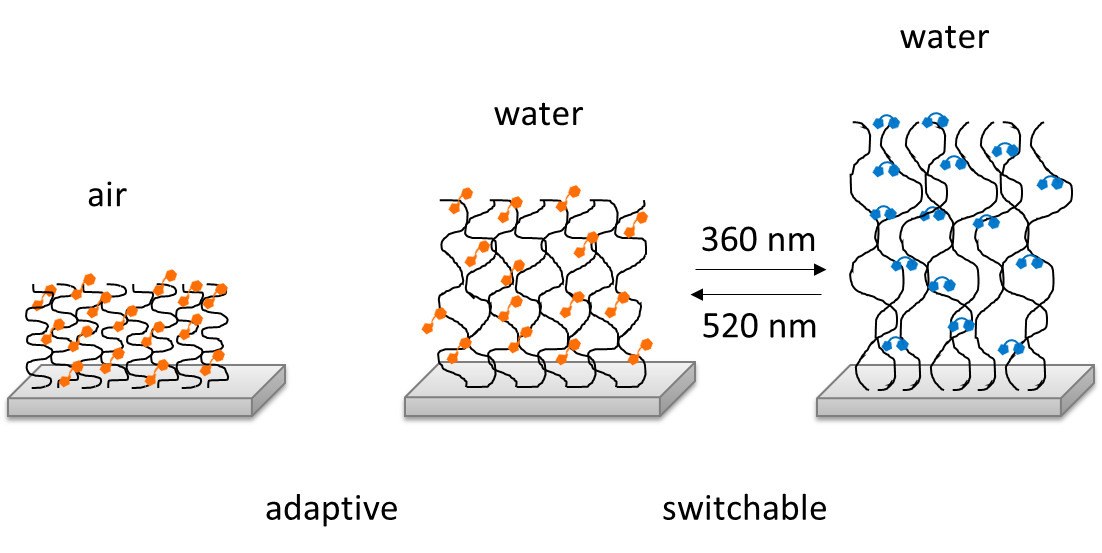
Adaptive und schaltbare Benetzung photoresponsiver Polymerbürsten mit eingebauten molekularen Photoschaltern.
Adaptive and switchable wetting of photoresponsive polymer brushes containing molecular photoswitches.
Selbstorganisation ist das Leitmotiv unserer Forschung. Unser Ziel ist es, funktionelle Strukturen und Materialien durch Selbstorganisation aus molekularen Bausteinen aufzubauen. Die Integration vieler Molekülen in komplexen und dynamischen Überstrukturen führt zu chemischen Systemen mit emergenten Eigenschaften die weit über die Summe der Komponente hinausgehen. Unsere Gruppe untersucht drei verwandte Themenbereiche: supramolekulare Chemie in Wasser, Oberflächenfunktionalisierung durch Selbstorganisation, und funktionalisierte Nanopartikel. Vor allem interessiert uns die Entwicklung responsiver und adaptiver Nanomaterialien durch die Selbstorganisation von steuerbaren molekularen Bausteinen.
Self-assembly is the Leitmotiv of the research in my group. Our aim is to use molecules as nanoscale building blocks for the construction of materials and devices by self-assembly. The assembly of many molecules into complex and dynamic superstructures gives rise to chemical systems with emerging properties that are much more than the sum of the components. The group focuses on three main areas of research: supramolecular chemistry in water, surface functionalization by molecular self-organization and functional (nano)particles. Increasingly, we focus on the development of responsive and adaptive nanomaterials based on the self-assembly of stimulus-response molecular building blocks.
https://www.uni-muenster.de/Chemie.oc/ravoo/
Center for Soft Nanoscience: https://www.uni-muenster.de/SON/
References:
- Arndt, N.B.; Schlüter, F.; Böckmann, M.; Adolphs, T.; Arlinghaus, H.F.; Doltsinis, N.L.; Ravoo, B.J. Self-assembled monolayers of arylazopyrazoles on glass and silicon oxide: Photoisomerization and photoresponsive wettability. Langmuir 2022, 38, 735–742.
- Buten, C.; Kortekaas, L.; Ravoo, B.J. Design of active interfaces using responsive molecular components. Adv. Mater. 2020, 32, 1904957.
- Lamping, S.; Stricker, L.; Ravoo, B.J. Responsive surface adhesion based on host-guest interaction of polymer brushes with cyclodextrins and arylazopyrazoles. Polymer Chem. 2019, 10, 683–690.
- Stricker, L.; Böckmann, M.; Kirse, T.M.; Doltsinis, N.L.; Ravoo, B.J. Arylazopyrazole photoswitches in aqueous solution: Substituent effects, photophysical properties and host-guest chemistry. Chem. Eur. J. 2018, 24, 8639–8647.
- Stricker, L.; Fritz, E.C.; Peterlechner, M.; Doltsinis, N.L.; Ravoo, B.J. Arylazopyrazoles as light-responsive molecular switches in cyclodextrin-based supramolecular systems. J. Am. Chem. Soc. 2016, 138, 4547–4554.
Dynamic behavior of water droplets on flexible, adaptive and switchable surfaces generated using surface attached polymer networks and brushes - J. Rühe
PI: Jürgen Rühe, Albert-Ludwigs-Universität Freiburg, Institut für Mikrosystemtechnik (IMTEK), Lehrstuhl Chemie und Physik der Grenzflächen, Georges-Koehler-Allee 103, 79110 Freiburg
Übergeordnetes Ziel des Forschungsprojektes im Rahmen des Schwerpunktprogramms ist es, Substratoberflächen mit einer maßgeschneiderten Chemie und Topographie zu erzeugen, die dynamisch auf Veränderungen in der Umgebung reagieren können, und das Benetzungsverhalten einfacher Flüssigkeiten auf solchen rekonfigurierbaren Oberflächen zu untersuchen. Ziel ist es, ein tieferes Verständnis in die Dynamik der Be- und Entnetzung solcher Flüssigkeiten auf schaltbaren Substraten zu erhalten. Wir werden uns vor allem auf experimentelle Methoden konzentrieren, aber auch die Ergebnisse mit theoretischen Analysen in Zusammenarbeit mit Wissenschaftlern des Schwerpunktprogramms kombinieren. Wir wollen im Wesentlichen zwei Konzeptlinien verfolgen, die im Laufe des Projekts zusammengeführt werden: 1. Wir werden Substrate erzeugen, bei denen eine spezifische Oberflächentopographie gewählt und die Oberflächenchemie so angepasst wird, dass dynamische Veränderungen durch z.B. Isomerisierungsreaktionen möglich sind. Diese Isomerisierungen ändern die Oberflächenenergie und führen dann zu einer dynamischen Änderung des Benetzungsverhaltens. 2. Wir erzeugen Substrate, bei denen eine bestimmte Oberflächenchemie gewählt und die Oberfläche durch mikrotechnische Methoden rekonfigurierbar gemacht wird. Dabei kann die Oberflächentopographie entweder durch einen externen Stimulus von glatt auf rau geschaltet werden oder die Oberfläche verformt sich bei Flüssigkeitskontakt. In einigen Fällen wird der Schaltvorgang durch die Benetzungsflüssigkeit selbst ausgelöst, so dass ansprechbare/adaptive Oberflächen entstehen. Gegen Ende der Förderperiode werden die beiden Linien entweder durch die Erzeugung einer auf mehrere Reize ansprechenden Oberfläche zusammengeführt, wobei ein Reiz auf die Oberflächenchemie bzw. die Oberflächenpolarität und einer auf die Topographie wirkt. In anderen Fällen ist vorgesehen, die entwickelten Technologien als Werkzeugkasten zu nutzen, bei dem die Eigenschaften der Oberflächen in den beiden Projektlinien (stimulierte Oberflächenchemie und stimulierte Topographie) zu dynamisch rekonfigurierbaren Oberflächen kombiniert werden, wobei die dynamischen Veränderungen einen sehr starken Einfluss auf das Benetzungsverhalten haben.
Dynamic wetting phenomena and contact angle hysteresis of drops on polymer brushes and gels - F. Schmid, D. Vollmer
Dynamic wetting phenomena and contact angle hysteresis on polymer brushes and gels
Dynamische Benetzungsvorgänge und Kontaktwinkelhysterese auf Polymerbürsten und Gelen
PI: Prof. Friederike Schmid, Johannes Gutenberg University (JGU) Mainz, 55128 Mainz
PhD student: Rodrique Badr
PI: Apl. Prof. Doris Vollmer, Max-Planck-Institut für Polymerforschung Mainz
PhD student: Lukas Hauer
The long-term goal of our project is to understand the static and dynamic properties of the wetting ridge (shape and friction) of aqueous sessile drops on polymer brushes and gels. To obtain in-depth insight into the dynamic wetting phenomena we are approaching the problem experimentally (confocal microscopy complemented by interference microscopy and friction measurements) and numerically (coarse-grained molecular simulations).
As model system, we focused on polydimethylsiloxane (PDMS) brushes and gels with and without immersed free polymer chains. Remaining unbound molecules in the brush act as lubricant. They lead to formation of a wetting ridge, lower the contact angle hysteresis and roll-off angle. Lower contact angle hysteresis implies lower lateral adhesion and friction force. Free molecules also can induce cloaking of a water drop. We have demonstrated cloaking by confocal microscopy and molecular dynamic simulations. To simulate cloaking, we used many-body dissipative particle dynamics. In order to obtain a wetting ridge, we have shown that the parameters must be chosen such that the polymer-water surface tension is moderate, and the polymer-vapor surface tension is low. Therefore, the polymer-polymer cohesion must be close to the critical cohesion strength. With the wetting ridge formed, we can now measure microscopic contact angles and apparent “macroscopic” contact angles.
Free molecules also change the dynamic contact angles of PDMS gels. We even observed two different advancing contact angles while inflating a sessile drop at constant inflation rate. For lubricated surfaces we also monitored the reorganization of the wetting ridge time- and space resolved.
Apart from a better understanding of the reorganisation dynamics of the wetting ridge, we want to correlate the reorganisation dynamics with the friction forces. For this purpose, we first want to compare the experimentally and numerically determined force-velocity curves for brushes and, in a second step, for gels. From this, we hope to gain a local understanding of the relevant dissipation mechanisms. We also plan to quantify and understand the differences and similarities between PDMS gels and hydrogels.
Dieses Projekts zielt auf ein verbessertes Verständnis der statischen und dynamischen Eigenschaften des Benetzungsrings (Form und Reibung) ab, der wässrige Tropfen auf Polymerbürsten und Gelen umgibt. Um die dynamischen Benetzungsphänomene zu quantifizieren und die molekularen Dissipationsmechanismen zu verstehen, kombinieren wir konfokale Mikroskopie und Reibungsmessungen mit grobkörnigen Molekularsimulationen.
Als Modellsystem haben wir Polydimethylsiloxan (PDMS)-Bürsten und Gele mit und ohne freie Polymerketten verwendet. Die freien Moleküle in der Bürste bewirken Ausbildung eines Benetzungsrings und wirken als Schmiermittel. Sie verringern die Kontaktwinkelhysterese und den Abrollwinkel. Eine geringere Kontaktwinkelhysterese bedeutet eine geringere laterale Adhäsion- und Haftreibungskraft. Freie Moleküle können auch den Wassertropfen umhüllen, wie wir durch konfokale Mikroskopie und molekulardynamische Simulationen (dissipativer Vielteilchendynamik) nachgewiesen haben. Für die Ausbildung eines Benetzungsringes müssen die Oberflächenspannung zwischen Polymer und Wasser moderat und die Oberflächenspannung zwischen Polymer und Luft niedrig sein. Dies lässt sich erreichen, wenn die Polymer-Polymer-Kohäsion in der Nähe der kritischen Kohäsionsstärke liegt. Unsere Simulationen erlauben nun den mikroskopischen Kontaktwinkel und den "makroskopischen" Kontaktwinkel zu vermessen.
Freie Moleküle verändern auch den dynamischen Kontaktwinkel von PDMS-Gelen. Bei kontinuierlicher Zunahme des Tropfenvolumens konnten wir zwei unterschiedliche Fortschreitkontaktwinkel nachweisen. Bei geschmierten Oberflächen haben wir die Reorganisation des Benetzungsrings orts- und zeitaufgelöst verfolgt.
Abgesehen vom besseren Verständnis der Reorganisationsdynamik wollen wir die Reorganisationsdynamik mit den Reibungskräften korrelieren. Dafür wollen wir zunächst die experimentell und numerisch ermittelten Kraft-Geschwindigkeits-Kurven für Bürsten und im zweiten Schritt für Gele korrelieren. Davon erhoffen wir ein lokales Verständnis der relevanten Dissipationsmechanismen. Außerdem planen wir die Unterschiede und Gemeinsamkeiten zwischen PDMS-Gelen und Hydrogelen zu quantifizieren und zu verstehen.
Schmid: http://www.komet1.physik.uni-mainz.de/
Vollmer: https://www.mpip-mainz.mpg.de/de/butt/gruppen/vollmer
Project-related publications:
- Polymer brushes with reversibly tuning grafting density; L.I. Klushin, A. M. Skvortsov, A.A. Polotsky, A.S. Ivanova and F. Schmid, J. Chem. Phys. 2021, 154, 074904.
- How a water drop removes a particle from a hydrophobic surface; A. Naga, A. Kaltbeitzel, W.S.Y. Wong, L. Hauer, H.-J. Butt and D. Vollmer, Soft Matter, 2021, 17, 1746.
- How frost forms and grows on lubricated micro- and nanostructured surfaces; L. Hauer, W.S.Y. Wong, V. Donadei, K.I. Hegner, L. Kondic, and D. Vollmer, ACS Nano 2021, 15, 4658.
- Grafting silicone at room temperature - a transparent, scratch-resistant nonstick molecular coating; H. Teisala, P. Baumli, S.A.L. Weber, D. Vollmer, and H.-J. Butt, Langmuir 2020, 36, 4416.
- Adaptive wetting of polydimethylsiloxane; W.S.Y. Wong, L. Hauer, A. Naga, A. Kaltbeitzel, P. Baumli, R. Berger, M. D‘Acunzi, D. Vollmer, and H.-J. Butt, Langmuir 2020, 36, 7236.
- Computing bulk and shear viscosities from simulations of fluids with dissipative and stochastic interactions; G. Jung and F. Schmid, J. Chem. Phys. 2016, 144, 204104.
- Polydisperse polymer brushes: Internal structure, critical behavior, and interaction with flow; S. Qi, L.I. Klushin, A.M. Skvortsov and F. Schmid, Macromolecules 2016, 49, 9667.
- Direct observation of drops on slippery lubricant-infused surfaces; F. Schellenberger, J. Xie, N. Encinas, A. Hardy, M. Klapper, P. Papadopoulos, H.-J. Butt and D. Vollmer, Soft Matter 2015, 11, 7617.

Dynamic wetting and dewetting of viscous liquid droplets films on viscoelastic substrates - R. Seemann, B. A. Wagner
PIs:
Prof. Dr. Ralf Seemann, Universität des Saarlandes
Prof. Dr. Barbara Wagner, Weierstraß-Institut für Angewandte Analysis und Stochastik (WIAS)
PhD students: Leonie Schmeller (WIAS), Khalil Remini (Universität des Saarlandes)
In our combined experimental and theoretical project, we are concerned about problems where a thin liquid film (or droplet) retracts from a viscoelastic substrate. The dewetting dynamics from viscoelastic substrates poses many open questions including the behavior of the contact angle at the three phase contact line, the dewetting rim and trench and the shape of the droplet in equilibrium. We consider very soft elastic substrate materials, such as for example PDMS Sylgard 184 and Sylgard 186 or gels like (Cy52-276) to explore those processes at the nanoscale using atomic force microscopy. Such gels typically also contain a fraction of un-cross-linked PDMS chains that may lead to stress induced phase separation, which we propose to occur at the contact line with liquid layer or droplet. This is sketched in Figure 1. To capture this phenomena we couple a model for a hydrogel that includes interfacial energy [1], with a model for a liquid viscous layer. The hydrogel model, which combines a network of cross-linked polymer chains and a liquid (not cross-linked) accounts for nonlinear (Neo-Hookian) elastic energy of the network, a mixing energy. The first step was to develop a weak formulation for the nonlinear system, which is then coupled to formulate a Cahn-Hillard or Flory-Huggins type dynamic system. Following the implementation in Matlab we will begin to couple the existing system with a model for a liquid viscous droplet or thin film on top of it. Especially on the numerical development we collaborate with the project (within this SPP) lead by Dirk Peschka. We also expect to use our hydrogel model and our numerical algorithm for other problems relevant within the SPP. Besides we hope to confirm or refine experimental findings on the nanoscale that are conducted on the macro-scale by other projects within the SPP.
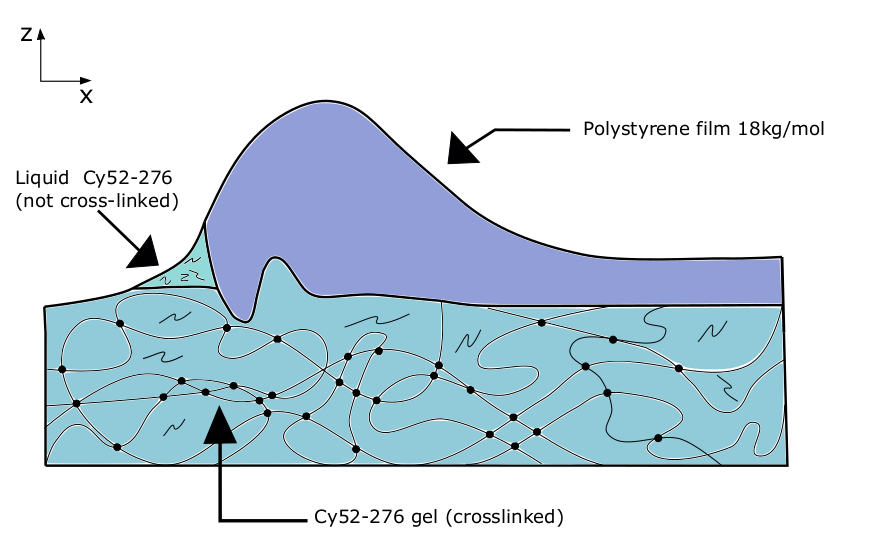
Figure 1: Scheme of a dewetting Polystyrene film from a soft Cy52-276 gel creating a phase-separated region of
liquid (un-cross-linked) Cy52-276.
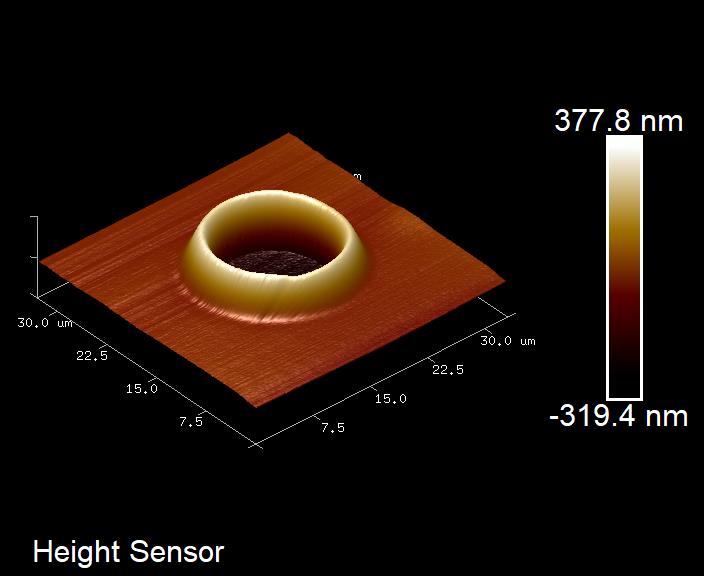
Figure 2: AFM scan of a hole created by the dewetting of PS 18k on SY184.
References:
[1] Matthew G Hennessy, Andreas Münch, and Barbara Wagner. “Phase separation in swelling and deswelling
hydrogels with a free boundary”. In: Physical Review E 101.3 (2020), p. 032501.
Intrinsic analysis of dynamic wetting on soft surfaces - M. Sega
PI: Marcello Sega, Forschungszentrum Jülich, Nürnberg, Germany
Post-Doc: Amal K. Giri, Forschungszentrum Jülich, Nürnberg, Germany
Surface phenomena are remarkable because they are dominated by extreme forces localised right at the interfaces in a spatial domain that usually involves one to three molecular layers. Thermally activated surface capillary waves corrugate the interface on larger scales, frustrating the attempt to investigate its structure and dynamics at molecular resolution through conventional analyses of atomistic simulation trajectories. We employ and generalise intrinsic analysis approaches that undo the smearing effect of capillary waves to analyse the hydrodynamic fields of moving droplets. This way, we can obtain a description of the properties of the moving contact line region at an unprecedented resolution and investigate the validity and limits of continuum approaches when reaching the microscale.
References:
- Structure and scaling laws of liquid/vapor interfaces close to the critical point György Hantal, Pál Jedlovszky and Marcello Sega. arXiv preprint arXiv:2201.00911 (2022)
- Hydrodynamics at the moving contact line Amal K. Giri, Paolo Malgaretti, Dirk Peschka and Marcello Sega. WIAS Preprint (2911), 1-14 (2022) https://dx.doi.org/10.20347/WIAS.PREPRINT.2911
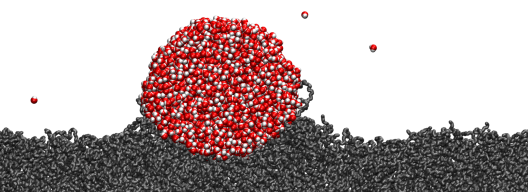
Ensembles of sitting and sliding drops on elastic media - experiment, simulation and theory - J. Snoeijer, U. Thiele
Ensembles of sitting and sliding drops on elastic media - experiment, simulation and theory
Ensembles sitzender und rutschender Tropfen auf elastischen Medien - Experiment, Simulation und Theorie
PIs: Jacco H Snoeijer, University of Twente, Physics of Fluids
Uwe Thiele, Westfälische Wilhelms-Universität Münster, Institut für Theoretische Physik
Other Team members: Christopher Henkel (Münster), Tuong Hoang (Twente)
Droplets on soft elastic substrates are a paradigmatic example of adaptive wetting, where capillarity-induced elastic deformations dramatically affect the wetting properties. Recent work has shown that substrates made from cross-linked polymer networks offer versatile routes to manipulate contact angles of droplets, as well as their spreading, directed motion, condensation and splashing. However, the full richness of these phenomena is only beginning to be explored and at present there is even no fully quantitative understanding of the behaviour of single drops -- let alone ensembles of drops. Key challenges lie in the intricate effects of solid surface tension, and how this affects the force balance near the contact line, while dynamics involves viscoelasticity of the substrate and elastocapillary interactions between droplets.
This project aims at developing and utilising experimental setups, detailed direct numerical simulations, effective long-wave models and a Smoluchowski-type statistical description to investigate the behaviour of drops of simple nonvolatile and volatile liquids on flexible substrates. The first part of the project focusses on single drops. We wish to develop detailed simulations that reveal the large-deformation mechanics near the contact line. The goal is a first-principles fully quantitive description of the wetting behaviour of single drops. This will form the basis for the second part of the project, where we will investigate the collective behaviour of ensembles of drops on soft substrates. Experiments on droplet ensembles, driven by external forcing or evaporation-condensation, will be complemented by a multi-scale modelling approach where we resolve the dynamics on different levels of detail. We develop effective long-wave models that are calibrated from the experimental and full simulation results for single drops, which opens the way for simulations of a large number of droplets, and ultimately for statistical modelling of drop ensembles.
Tröpfchen auf weichen elastischen Substraten sind ein paradigmatisches Beispiel für adaptive Benetzung, bei der Kapillaritäts-induzierte elastische Verformungen die Benetzungseigenschaften erheblich beeinflussen. Jüngste Arbeiten haben gezeigt, dass Substrate aus vernetzten Polymeren vielseitige Möglichkeiten bieten, Kontaktwinkel von Tröpfchen sowie deren Verteilung, gerichtete Bewegung, Kondensation und Aufprall zu manipulieren. Man hat lediglich begonnen, die volle Vielfalt dieser Phänomene zu erforschen, und derzeit gibt es noch nicht einmal ein vollständig quantitatives Verständnis des Verhaltens einzelner Tropfen - geschweige denn von Ensembles von Tropfen. Die größten Herausforderungen liegen dabei einereits in den komplizierten Effekten der Oberflächenspannung elastischer Festkörper und wie sich diese auf das Kräftegleichgewicht in der Nähe der Kontaktlinie auswirken. Andererseits wird die Dynamik von der Viskoelastizität des Substrats und den elastokapillaren Wechselwirkungen zwischen den Tröpfchen bestimmt.
Ziel dieses Projekts ist die Entwicklung und Nutzung von Versuchsaufbauten, detaillierten direkten numerischen Simulationen, effektiven Langwellenmodellen und einer statistischen Beschreibung vom Smoluchowski-typ zur Untersuchung des Verhaltens von Tropfen einfacher nichtflüchtiger und flüchtiger Flüssigkeiten auf flexiblen Substraten. Der erste Teil des Projekts konzentriert sich auf einzelne Tropfen. Wir wollen detaillierte Simulationen entwickeln, die die Mechanik großer Verformungen in der Nähe der Kontaktlinie zugänglich machen. Ziel ist eine vollständige quantitative first-principle Beschreibung des Benetzungsverhaltens einzelner Tropfen. Dies wird die Grundlage für den zweiten Teil des Projekts bilden, in dem wir das kollektive Verhalten von Tropfenensembles auf weichen Substraten untersuchen. Experimente an Ensembles, die durch eine externe Triebkraft oder Verdunstungs/Kondensation angetrieben werden, werden durch einen multiskaligen Modellierungsansatz ergänzt, bei dem wir die Dynamik mit verschiedenen Graden an Detail auflösen. Wir entwickeln effektive Langwellenmodelle, die aus den experimentellen und vollständigen Simulationsergebnissen für einzelne Tropfen kalibriert werden, was den Weg für die Simulation einer großen Anzahl von Tropfen und schließlich für die statistische Modellierung von Tropfenensembles öffnet.
Das wissenschaftliche Ziel der Arbeitsgruppe Selbstorganisation und Komplexität ist es, universelle Eigenschaften von Nichtgleichgewichtssystemen mit theoretischen und numerischen Methoden zu erforschen. Von besonderem Interesse sind dabei Methoden der nichtlinearen Dynamik wie Bifurkations- und Chaostheorie, welche mit Methoden der statistischen Physik und der Theorie stochastischer Prozesse kombiniert werden. Aktuelle Forschungsgebiete sind u.a. die raumzeitliche Strukturbildung in selbstassemblierenden Systemen und ihre Kontrolle, die Grenzflächendynamik komplexer Fluide & weicher Materie, die Dynamik von Phasenübergängen und Wachstumsprozessen und die kollektive Dynamik von Biofilmen, Bakterienkolonien, Geweben und Mikroschwimmern.
The scientific aim of the working group on Self-Organization and Complexity is to explore universal properties of non-equilibrium systems with theoretical and numerical methods. Of considerable interest are methods of nonlinear dynamics like bifurcation theory, chaos theory combined with methods of statistical physics and the theory of stochastic processes. Current areas of research are, e.g., spatio-temporal pattern formation in self-assembling systems and its control, interface dynamics for complex liquids & soft and active matter, dynamics of phase transitions and growth processes and the collective dynamics of biofilms, bacterial colonies, tissues and micro-swimmers.
https://www.uni-muenster.de/Physik.TP/en/research/thiele/
http://www.uwethiele.de
Sliding drops - ensemble statistics from single drop bifurcations
Markus Wilczek, Walter Tewes, Sebastian Engelnkemper, Svetlana V. Gurevich and Uwe Thiele
Phys. Rev. Lett. 119, 204501 (2017). doi:10.1103/PhysRevLett.119.204501;
Resting and Traveling Localized States in an Active Phase-Field-Crystal Model
Lukas Ophaus, Svetlana V. Gurevich and Uwe Thiele
Phys. Rev. E 98, 022608 (2018). doi:10.1103/PhysRevE.98.022608;
Modelling of surfactant-driven front instabilities in spreading bacterial colonies
Sarah Trinschek, Karin John and Uwe Thiele
Soft Matter 14, 4464-4476 (2018). doi:10.1039/c8sm00422f;
Recent advances in and future challenges for mesoscopic hydrodynamic modelling of complex wetting
Uwe Thiele, Colloids Surf. A 553, 487-495 (2018). doi:10.1016/j.colsurfa.2018.05.049;
B. Andreotti and J. H. Snoeijer, “Statics and Dynamics of Soft Wetting,” Ann. Rev. Fluid Mech., vol. 52, 2020.
We offer support in developing thin-film gradient dynamics models for your specific systems.
We can also provide numerical continuation and time-stepping tools to analyse and solve such equations. For an overview of capabilities for the former see
S. Engelnkemper, S. V. Gurevich, H. Uecker, D. Wetzel, and U. Thiele, “Continuation for thin film hydrodynamics and related scalar problems,” in Computational Modeling of Bifurcations and Instabilities in Fluid Mechanics, A. Gelfgat, Ed. Springer, 2019, pp. 459–501.

